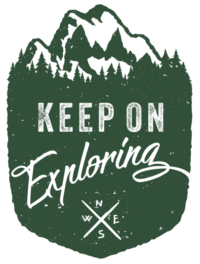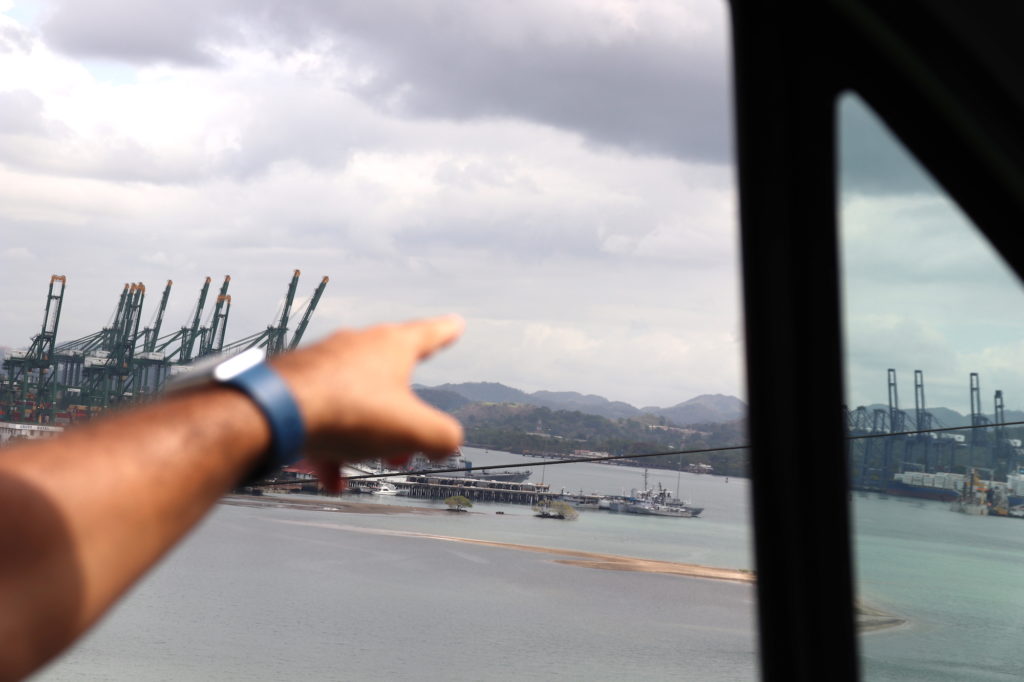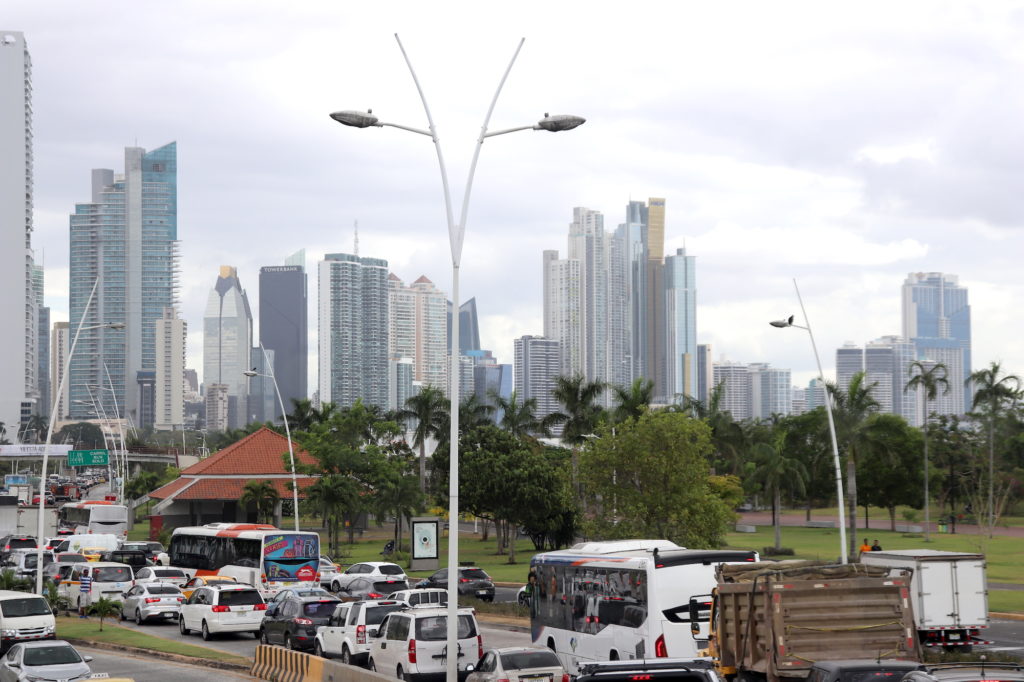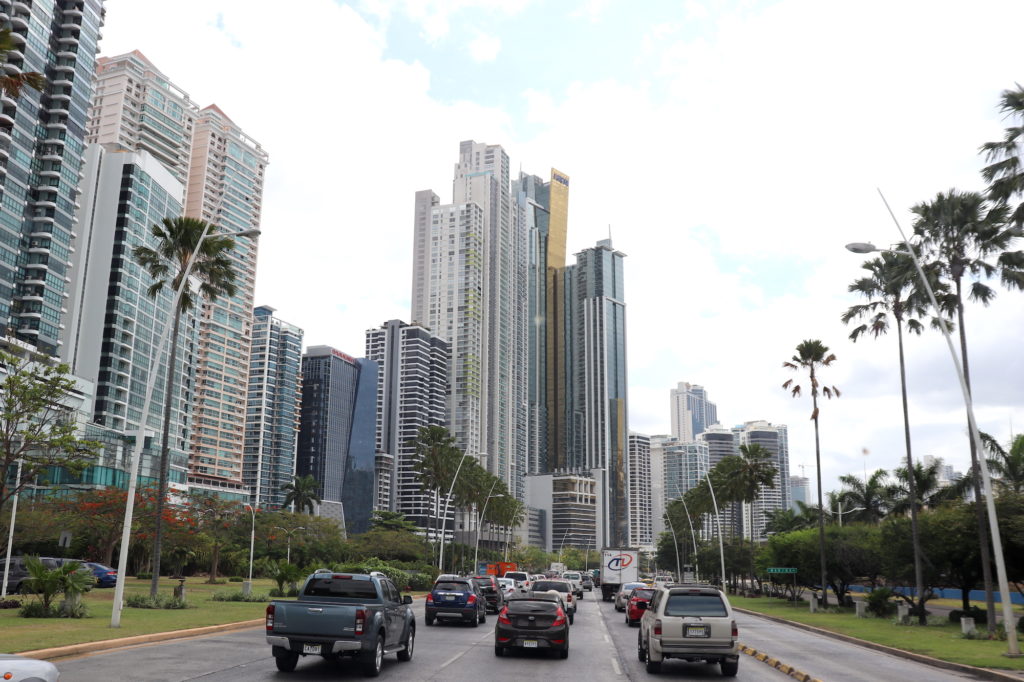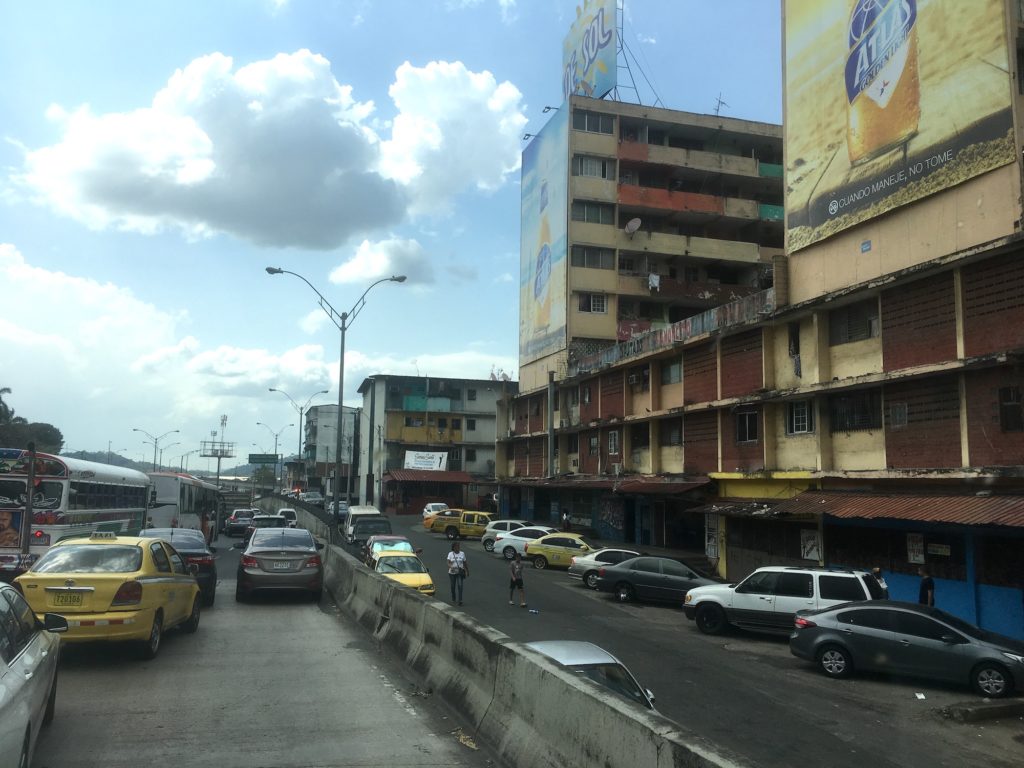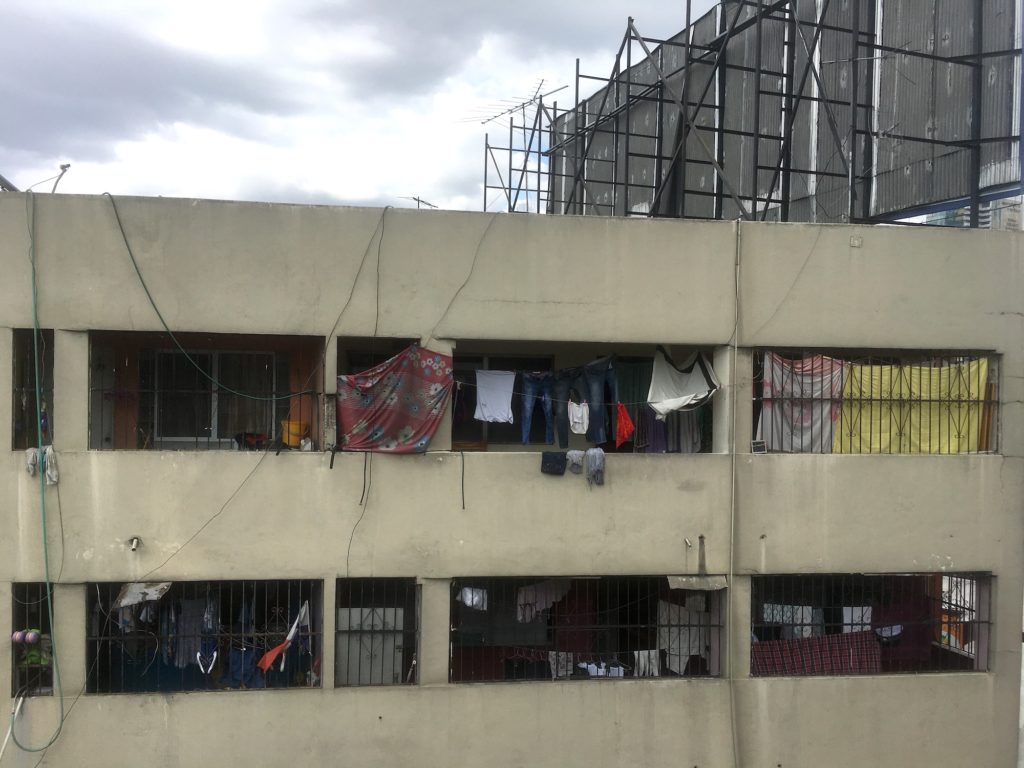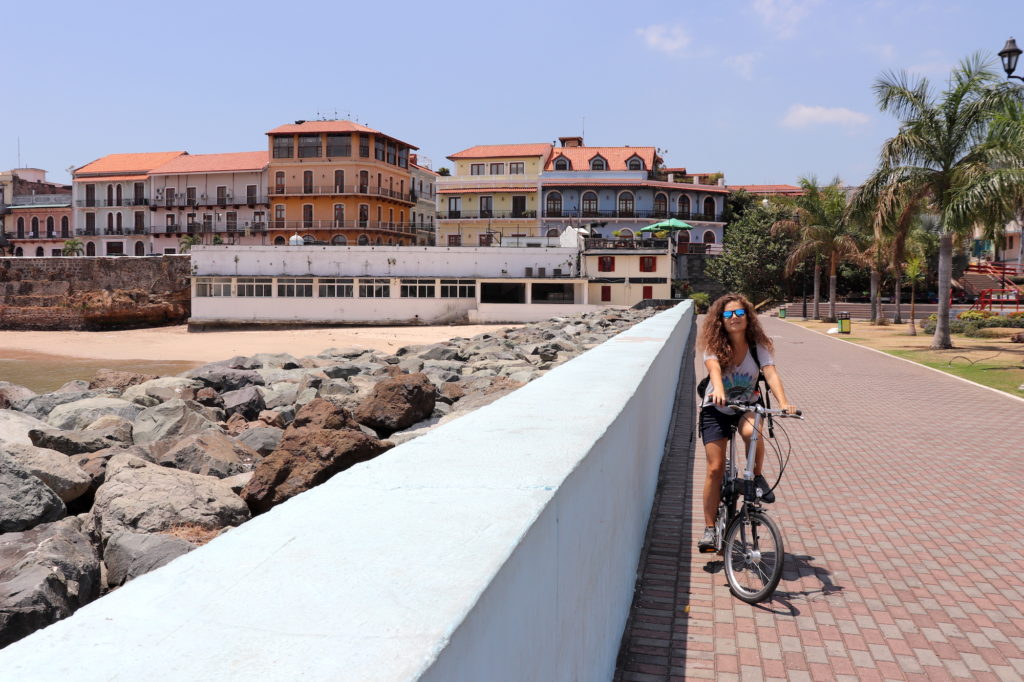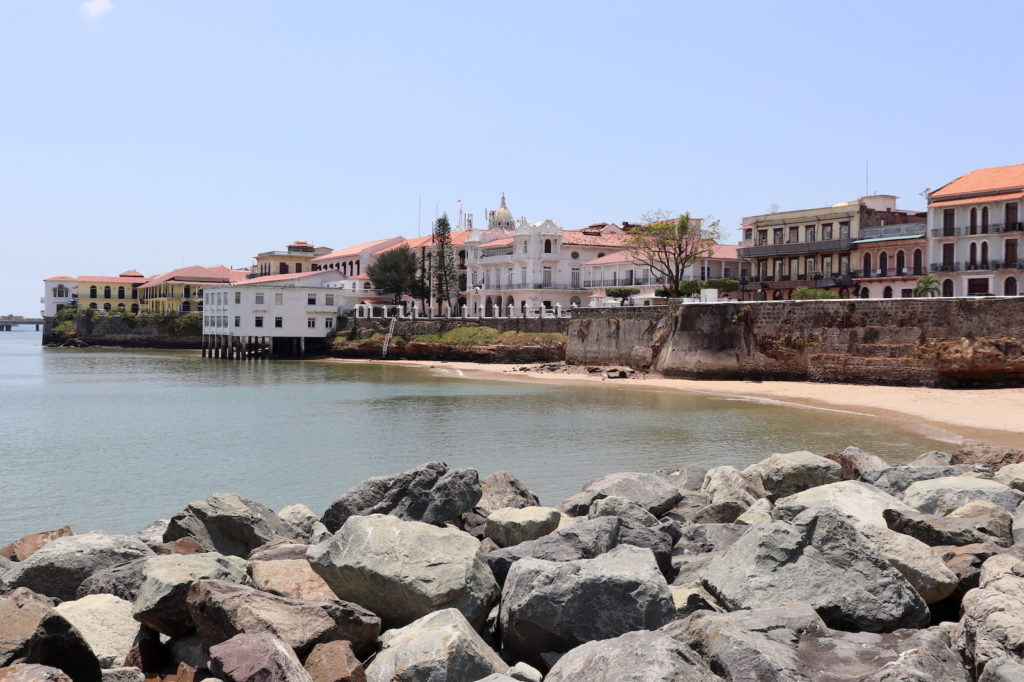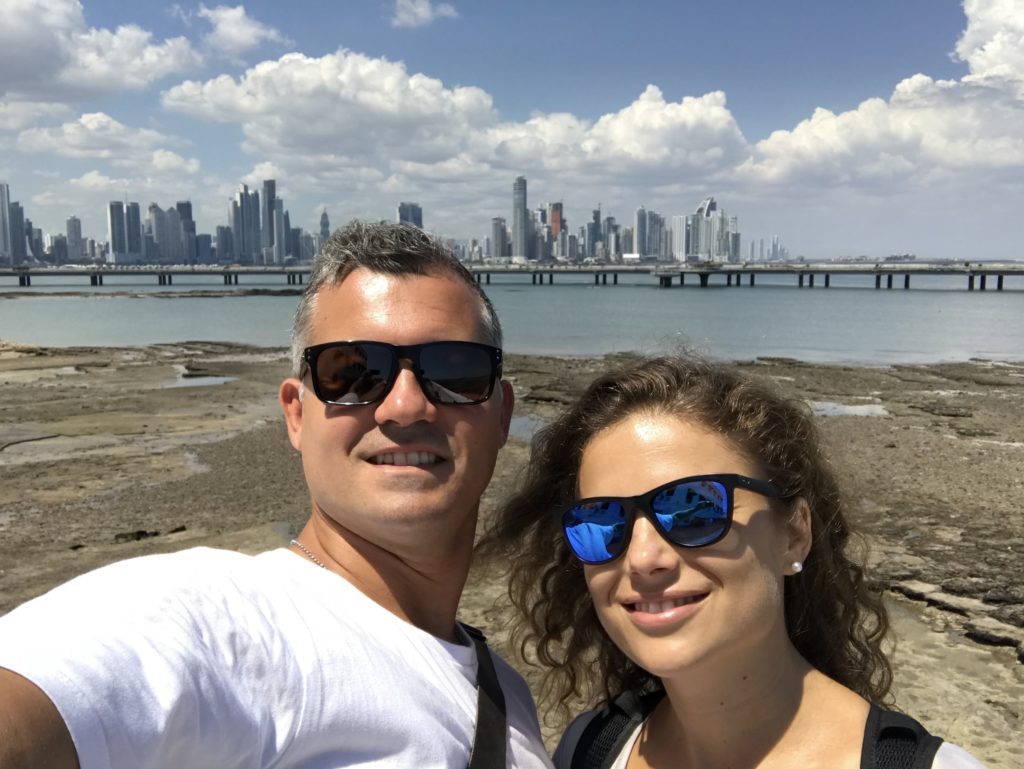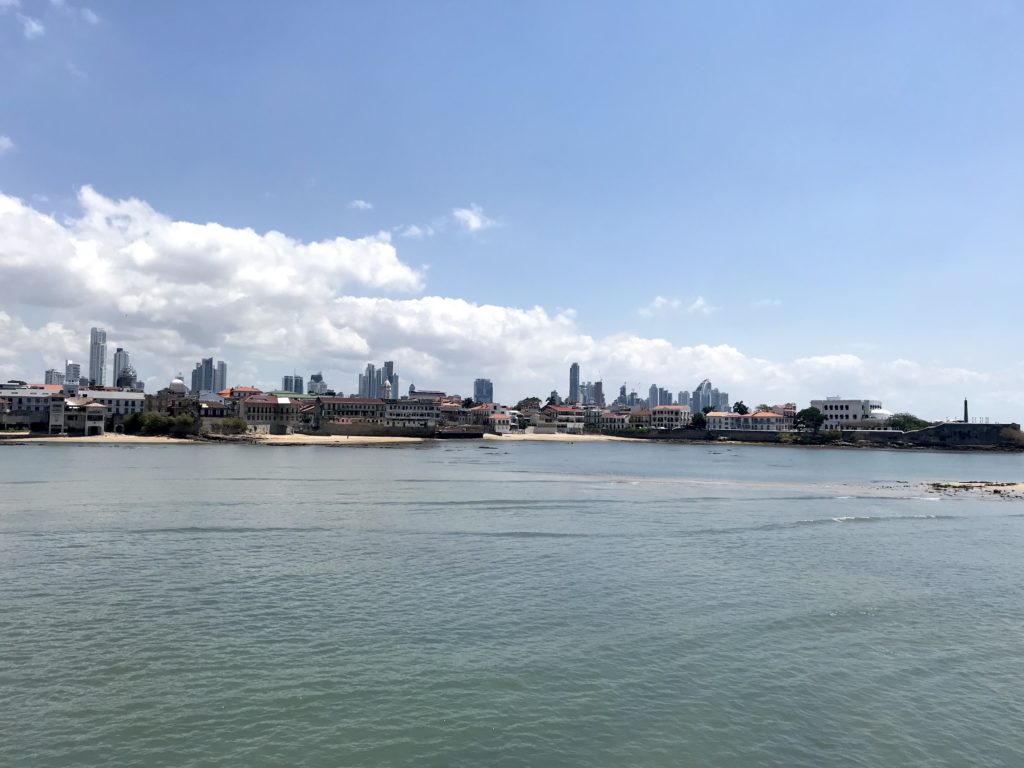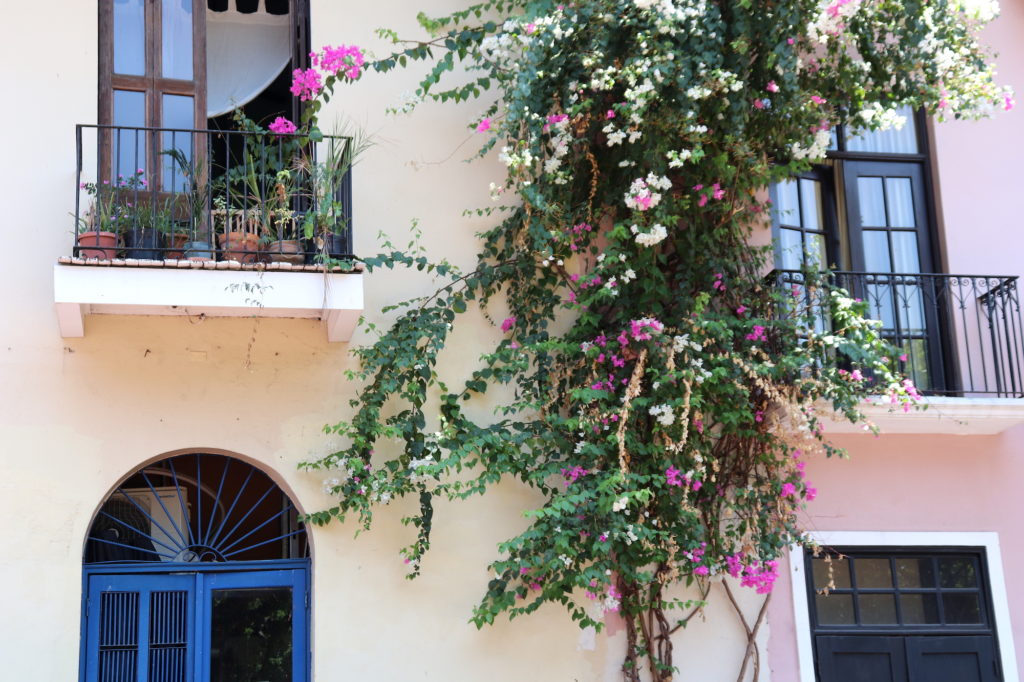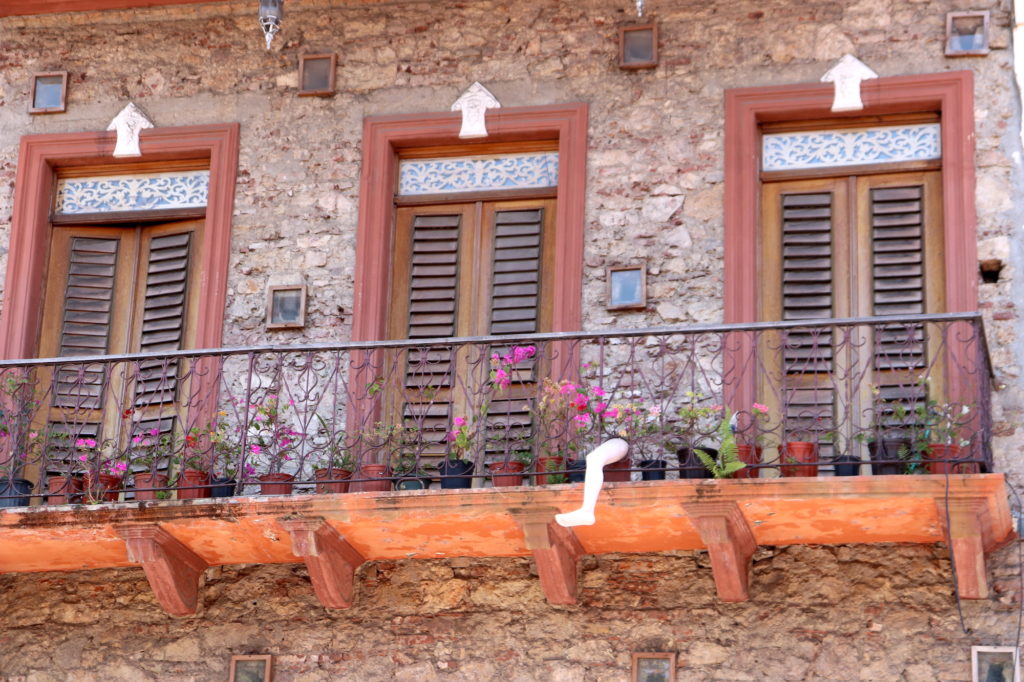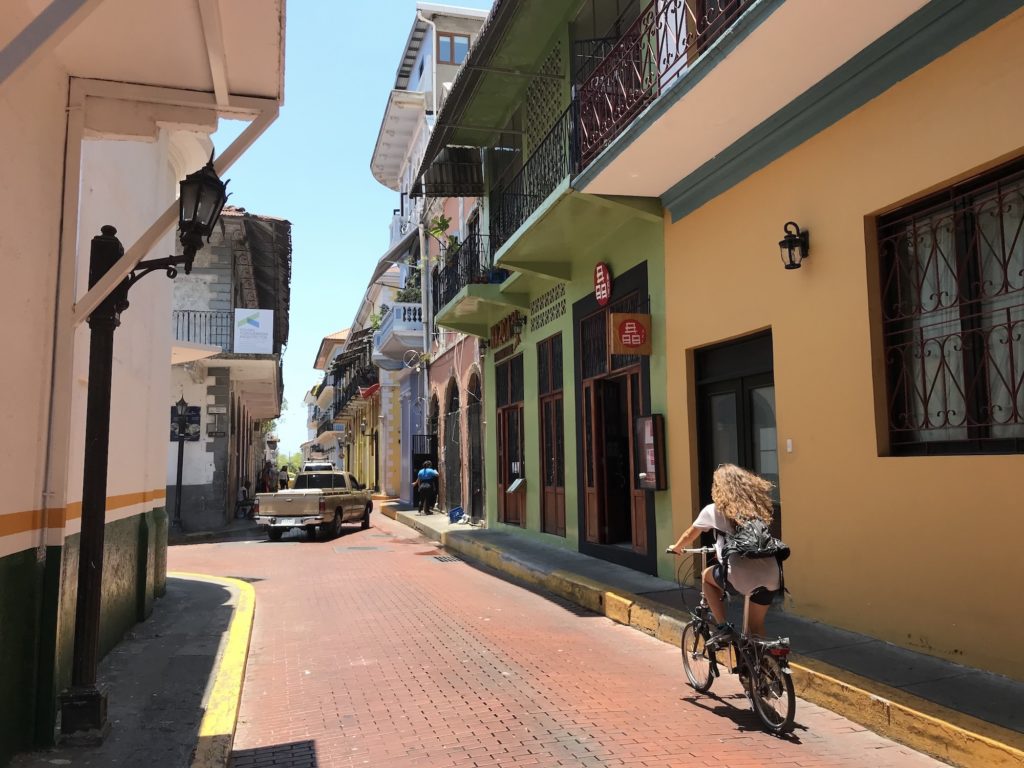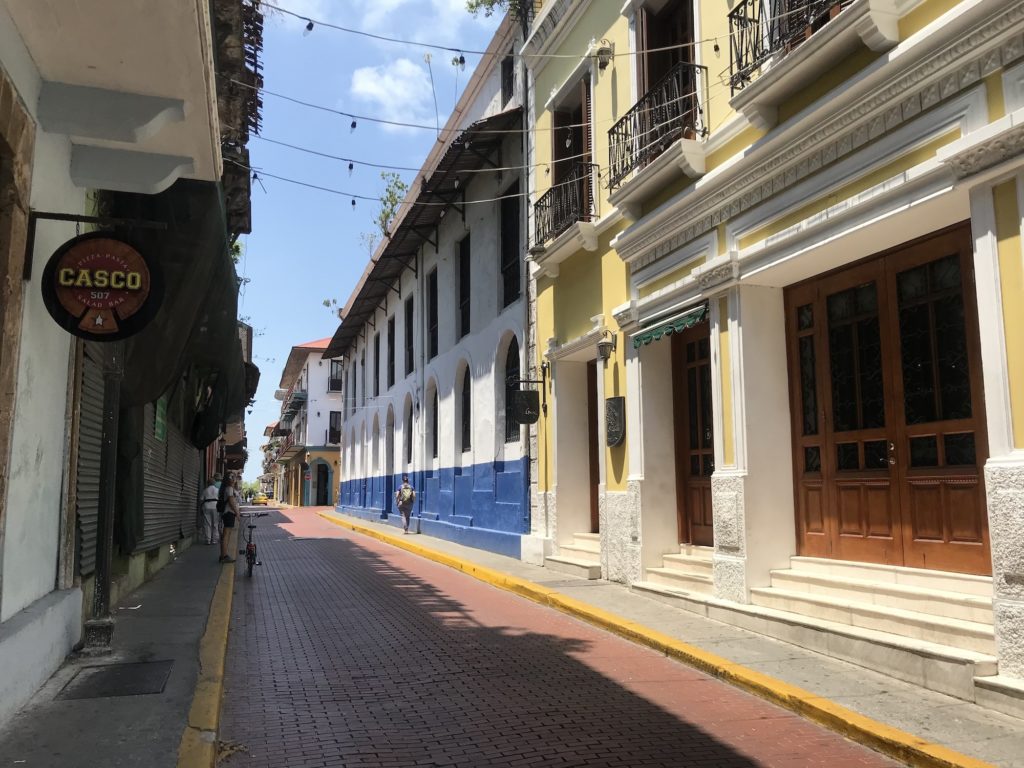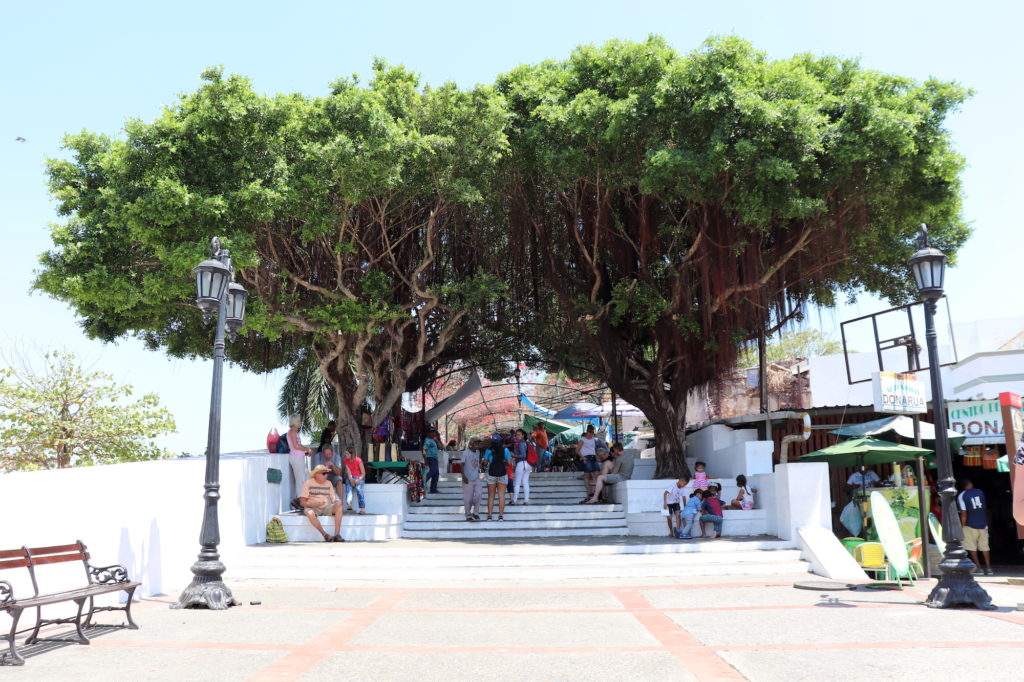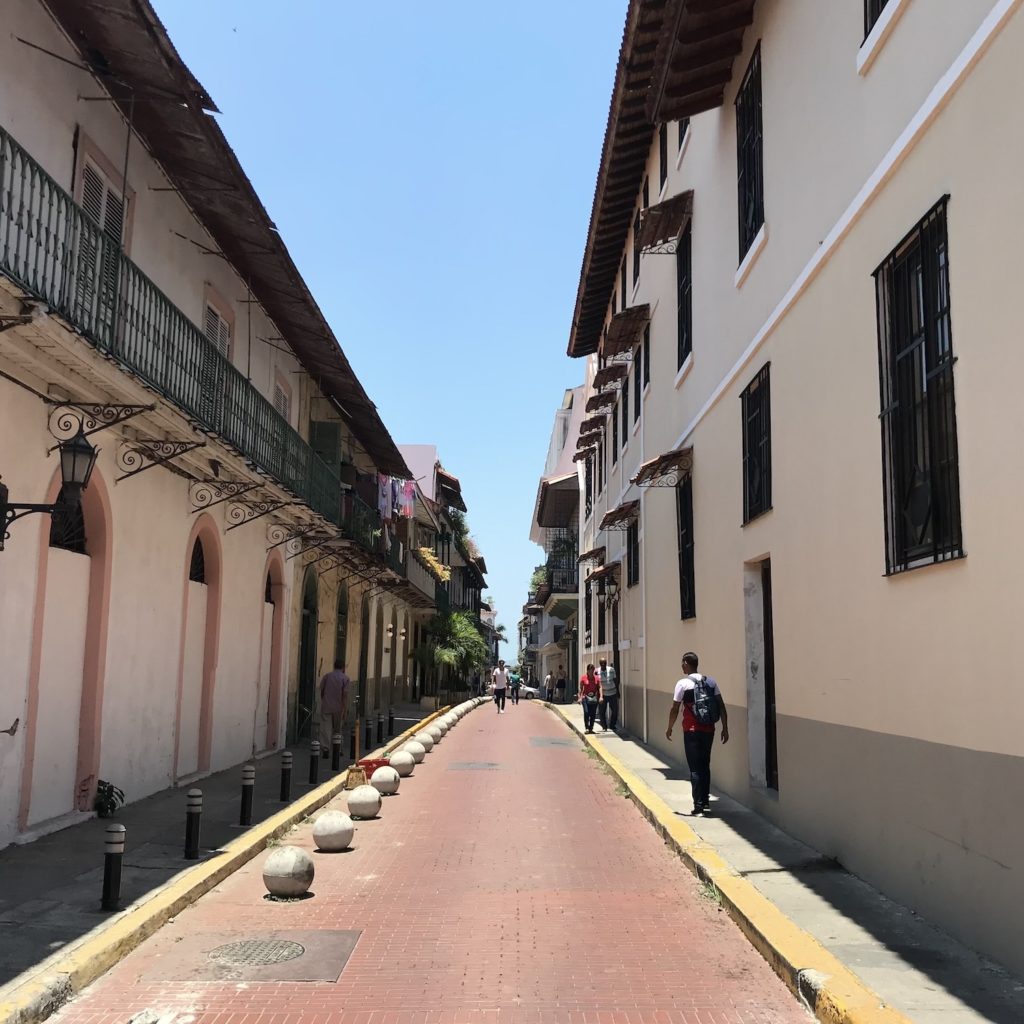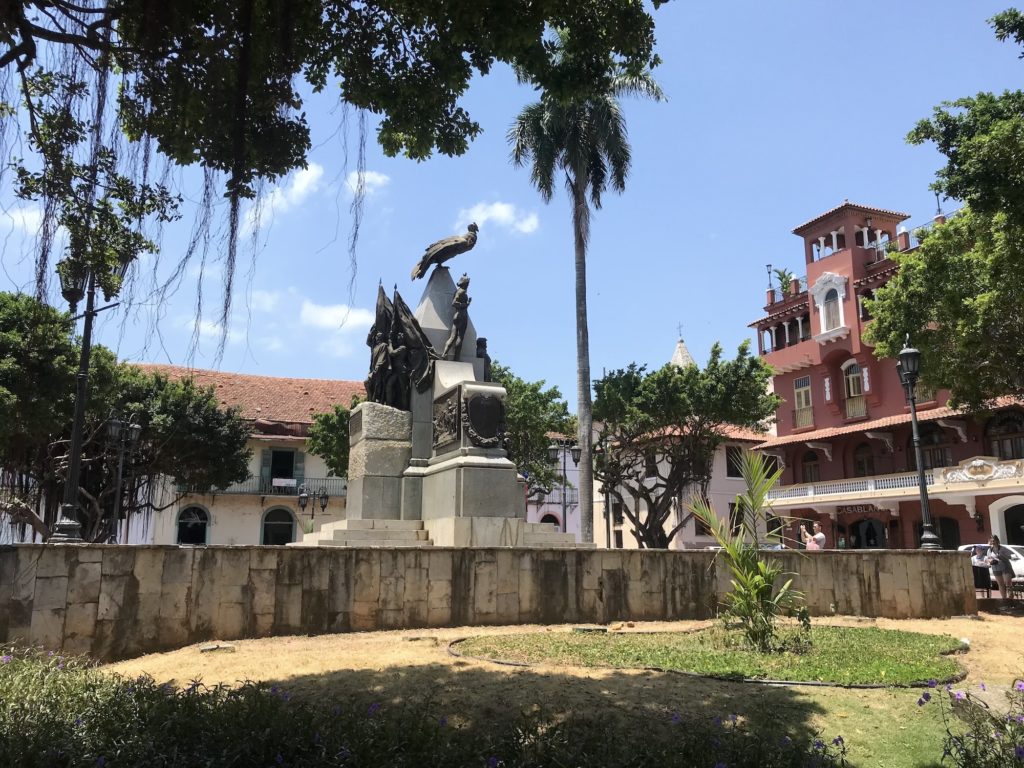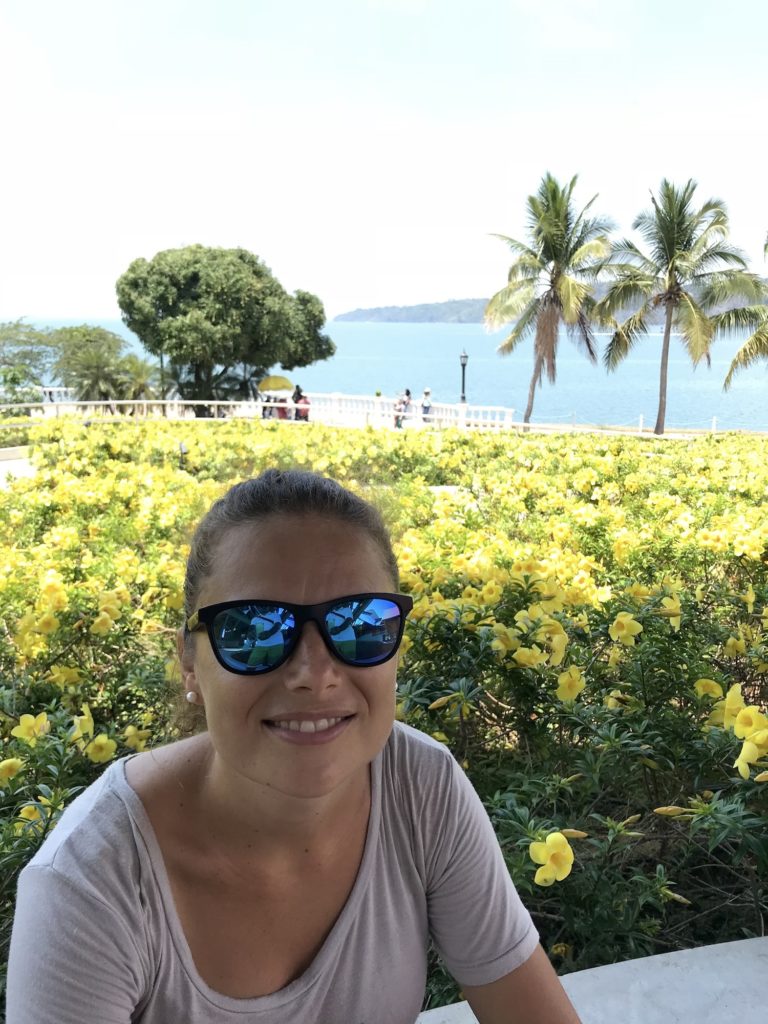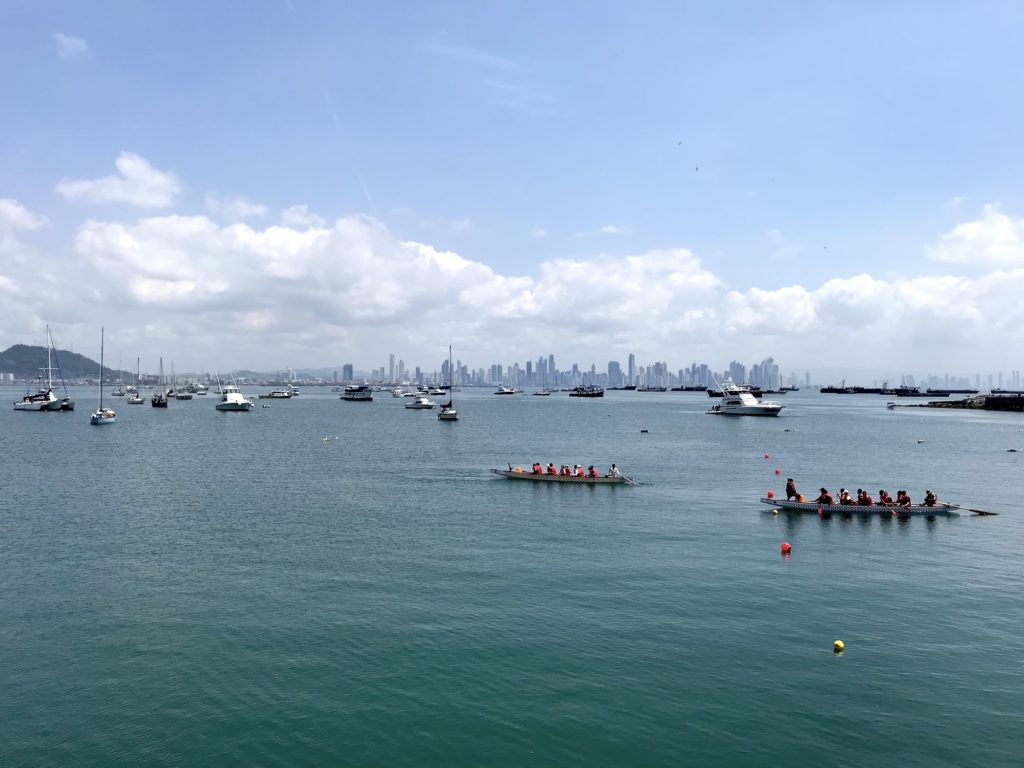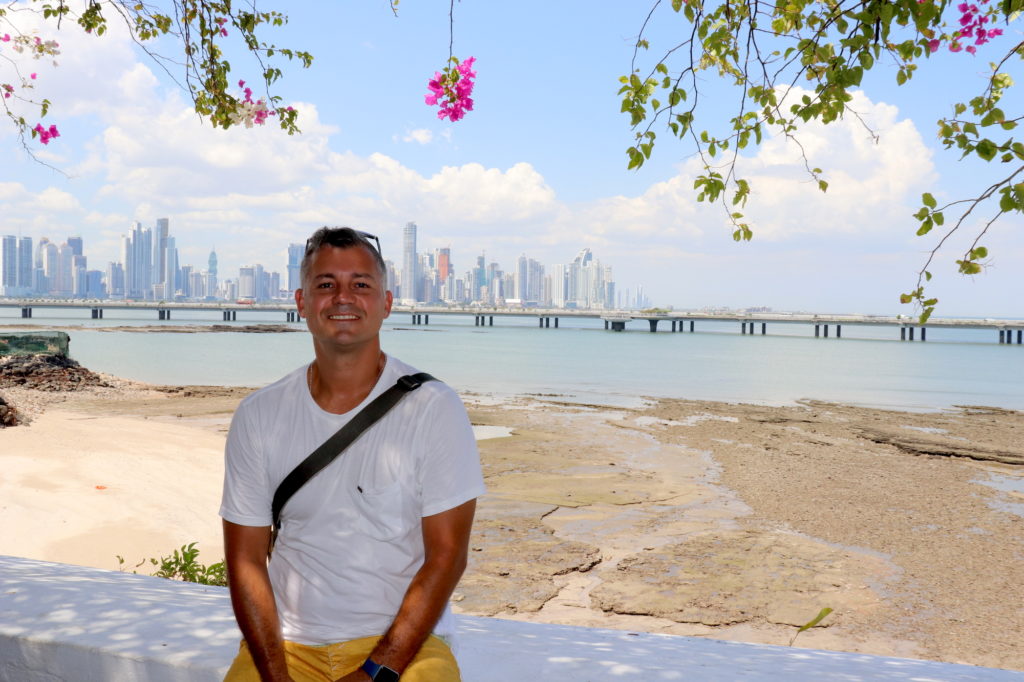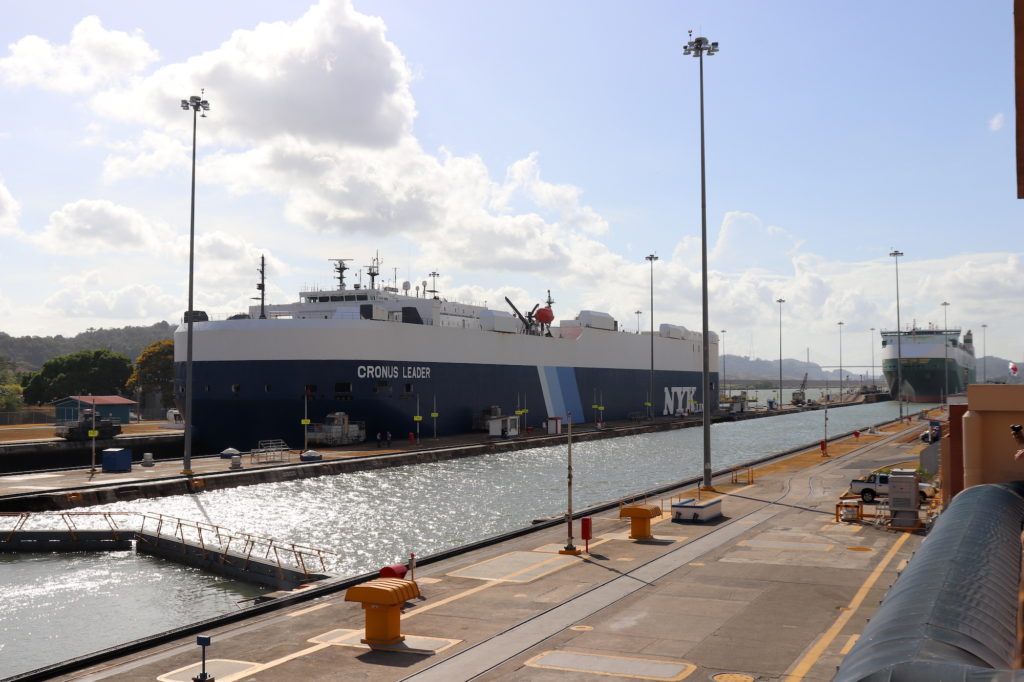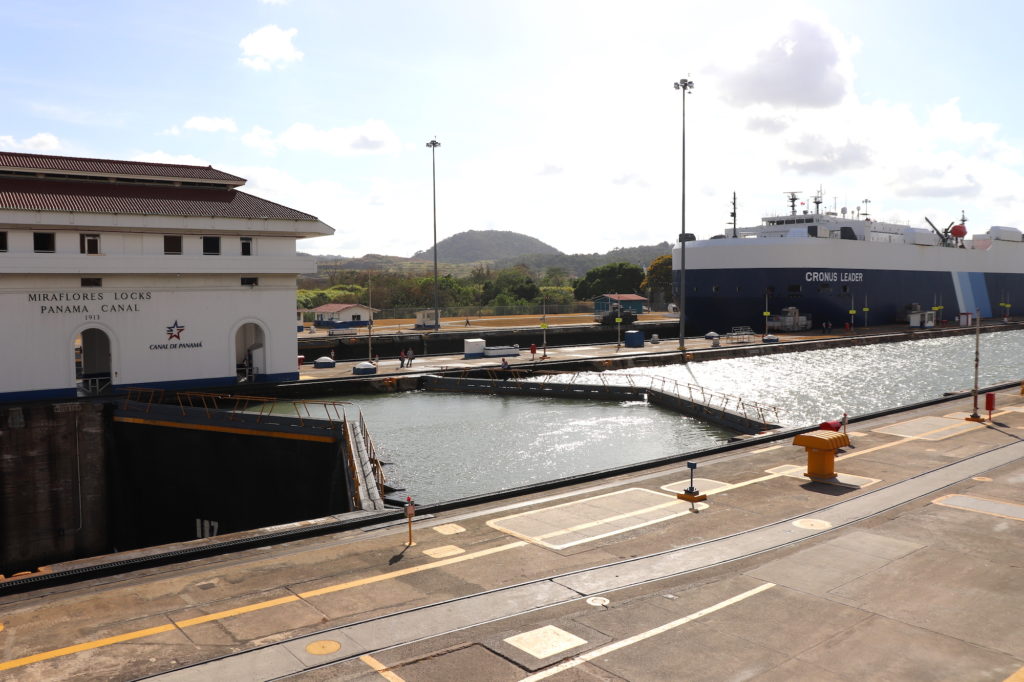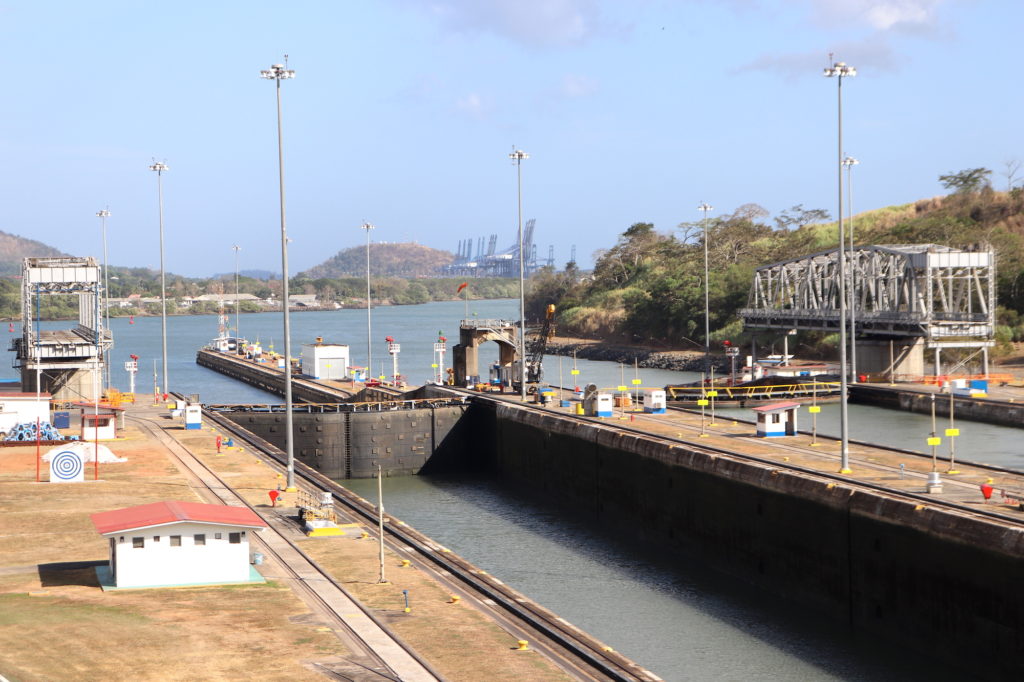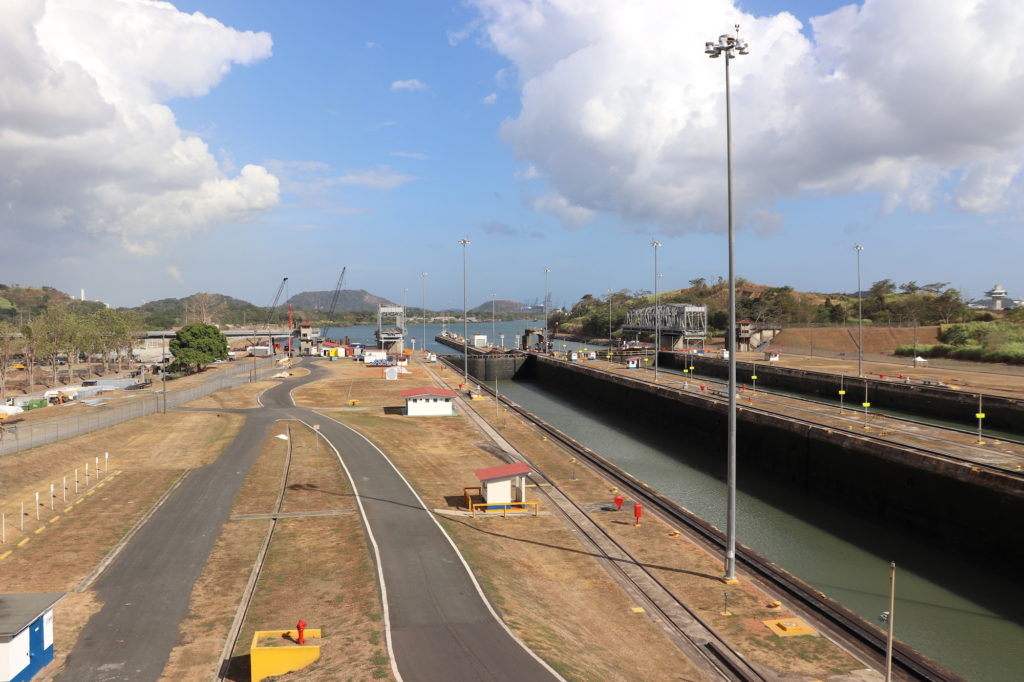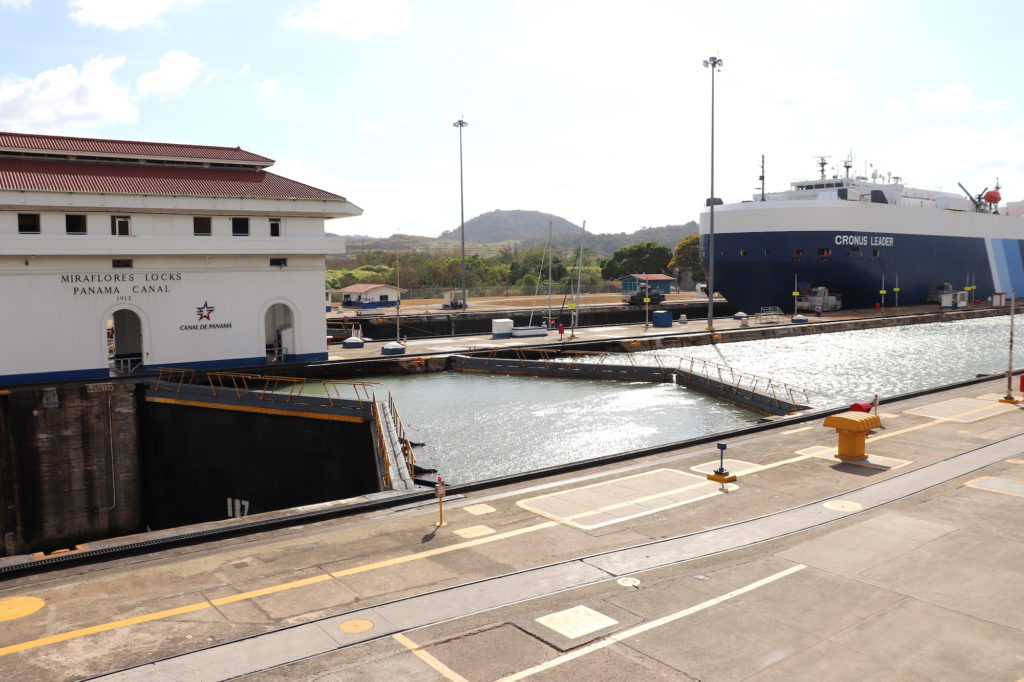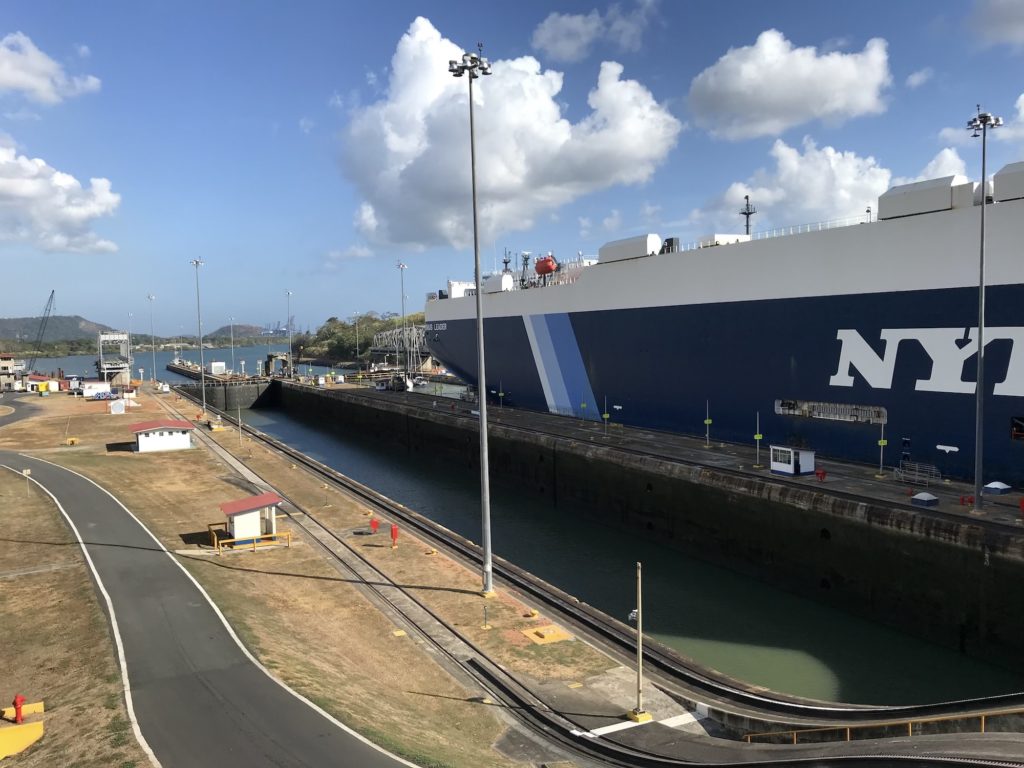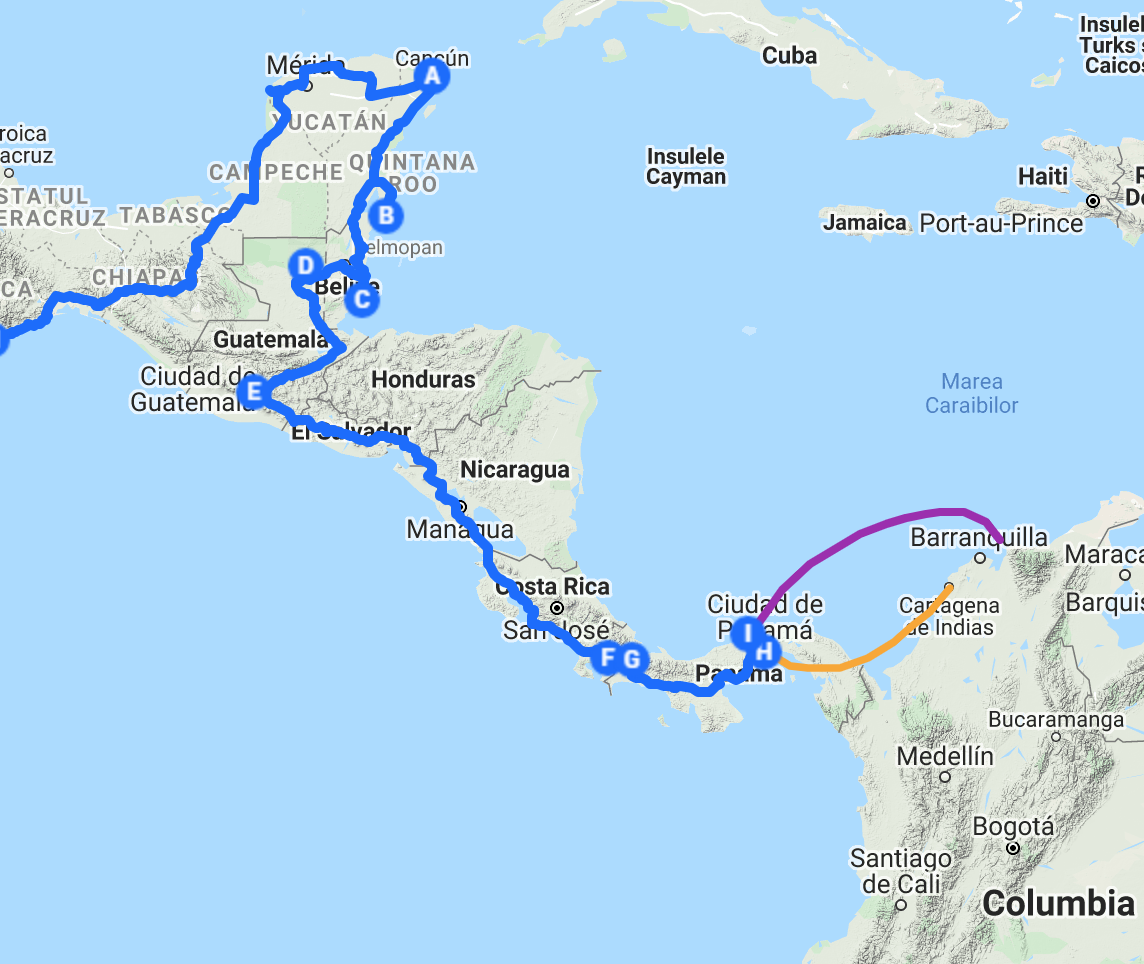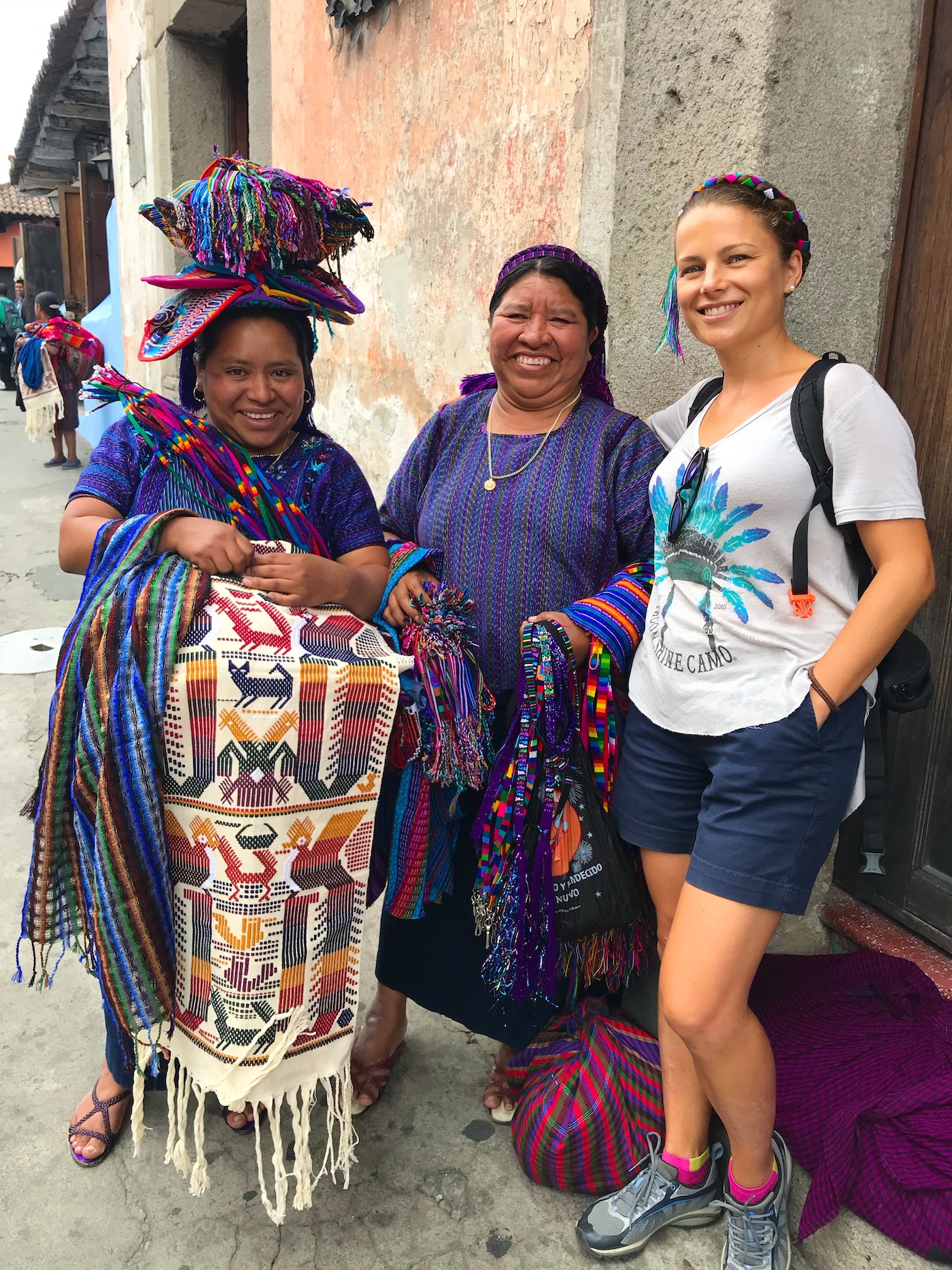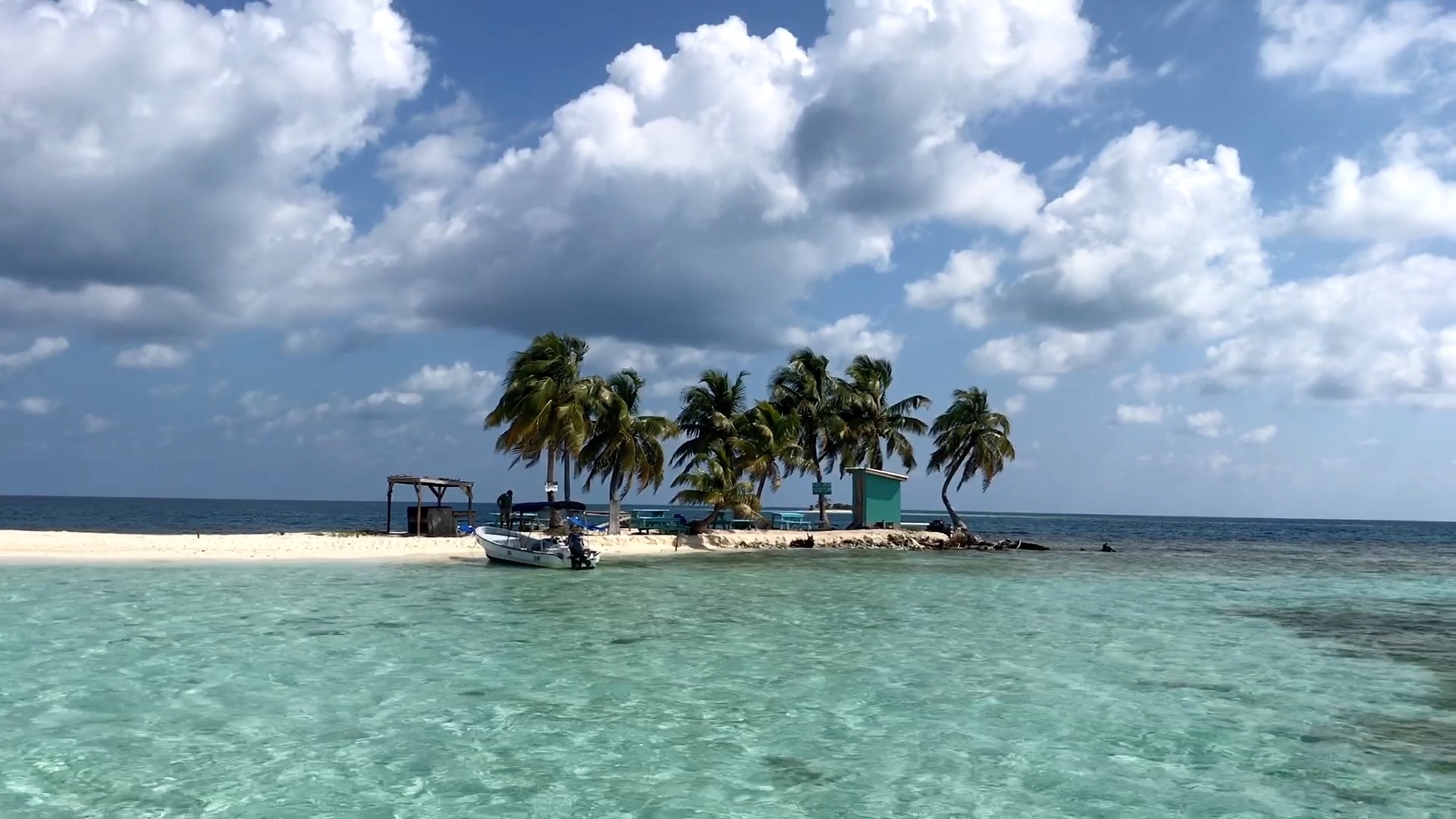Panama was the last Central American country to visit and it became a very important milestone in our expedition. We had several errands planned in its cosmopolitan capital besides touring around and visiting the world-famous Panama Canal. I was so excited and anxious to have my first prenatal examination, JP wanted to apply for a new Brazilian passport, and Brutus needed some well-deserved servicing before being shipped on a RoRo vessel to Colombia.
After we crossed the border we stopped in the mountain resort Boquete where we finally met the Tucks and their Cuthbert, who were an important source of inspiration for our expedition and decision to buy Brutus. From Boquete we headed towards the capital through well maintained highways. Panama City welcomed us with majestic views of the Panama Canal and imposing skyscrapers in the horizon. We were blown away by the world class man-made canal at Miraflores Locks, enjoyed the visits in the old town ‘Casco Viejo’, the modern Causeway and we built new friendships at Amador Familiar Hostel.
The Central American frequent border crossings were behind us. A new chapter was around the corner. South America here we come!
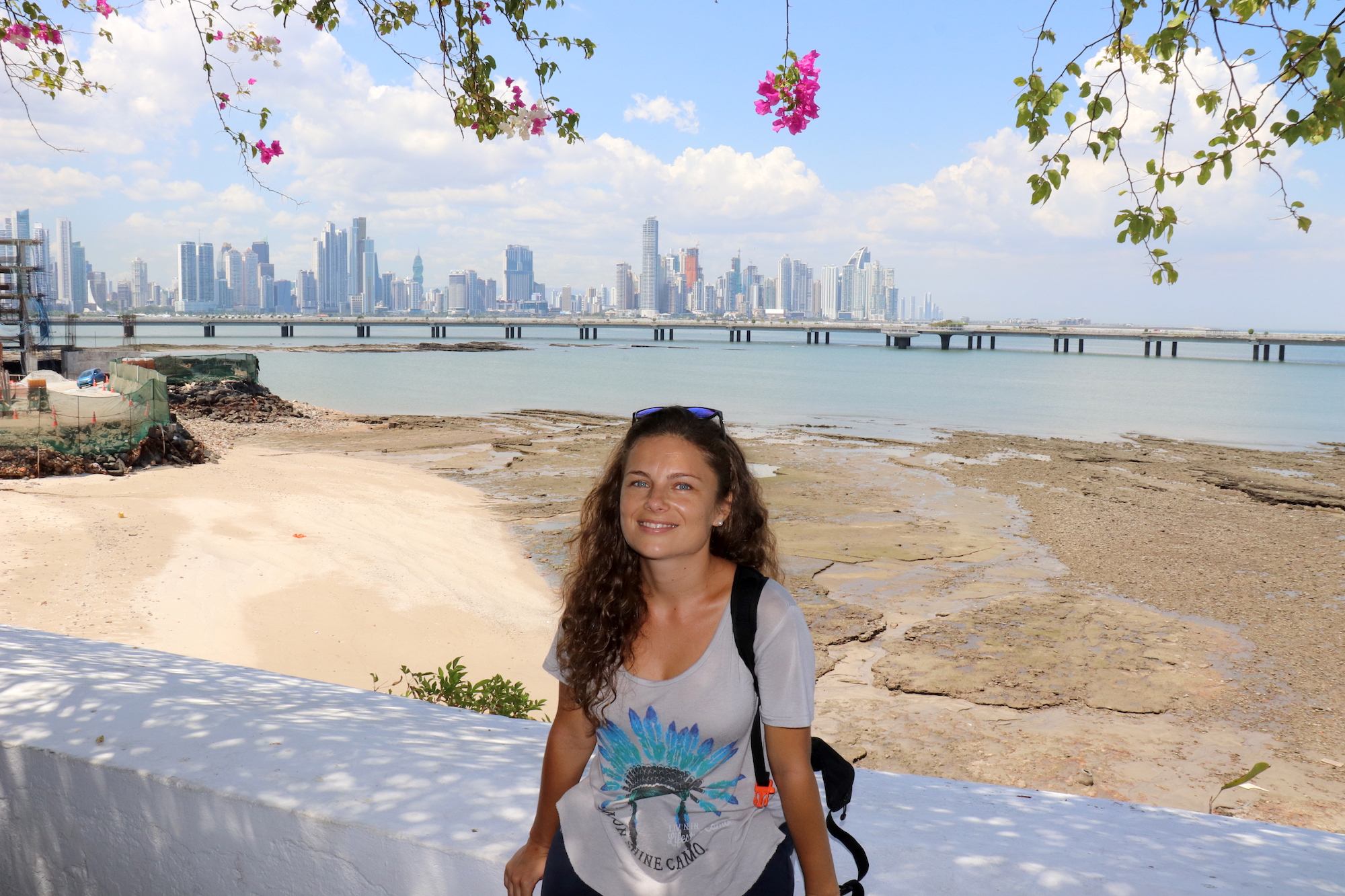
Boquete
We entered Panama crossing the border at Paso Canoas, in a relatively fast and painless exercise. From there we headed to Boquete, a small mountain town located about 60 kilometers from the border with Costa Rica, by the Caldera River. Because of its elevation, some 1200m above sea level its climate is quite pleasant. Boquete has a year-round spring like air, typical of a mountain resort. We were excited to get there as we also scheduled to meet Julie and Marcus Tuck.
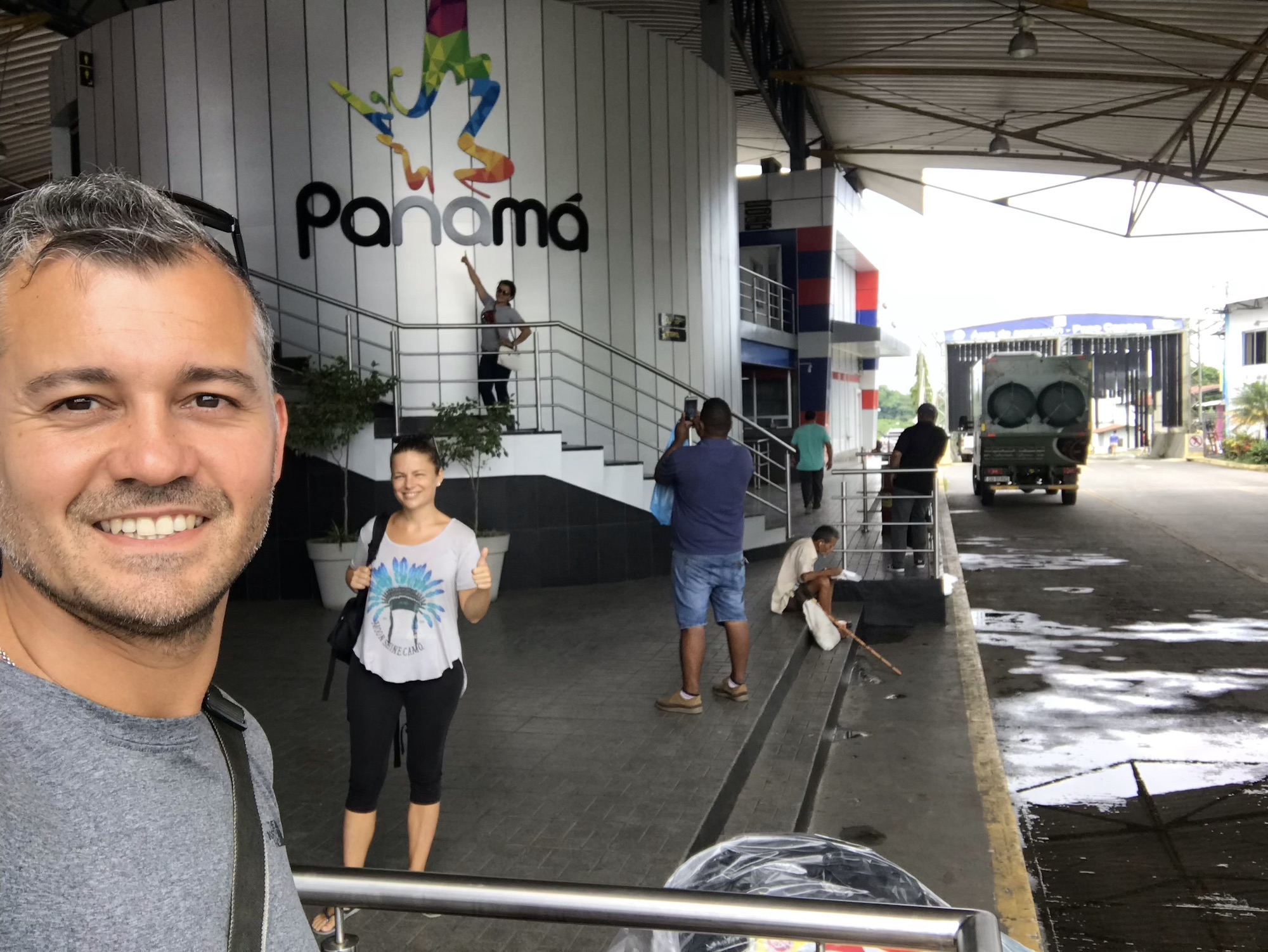
The Tucks are a fantastic British overlanding couple who started overlanding in 2014 and have been all around Africa before commencing their adventure in the Americas. They played an important role when we were deciding what type of 4x4 vehicle we would purchase. But more than that Marcus really inspired JP to get on the road with our Iveco 55S18W Daily 4x4 we named Brutus. JP read all about their adventures in Africa while we were still living in Dubai. At that time, he was researching in many blogs, trying to learn with different overlanders driving different types of vehicle what the best for our purposes would be. The ultimate reason for deciding for the Iveco Daily 4X4 55S18W was that Marcus really tested his Cuthbert to the limit on a wide variety of situations and took the time to document on his site. Marcus busted many myths about overlanding, including but not limited to that vehicles with more complex electronics and EPF would not function properly at altitude or with dirty fuel. He also helped to build the reputation of IVECO showing that a wide variety of problems attributable to the 55S18W model was in fact due to many buyers not following the manual, expected the vehicle to do things it was not designed to do or because they changed the vehicles original configuration without considering its implications. Of course, the 55S18W is not perfect, and as an example the breaks could be much better, but even then Marcus helped many on how to deal with this shortcoming. For these reasons, meeting the Tucks in Boquete was, for JP, like he would be meeting his gurus.
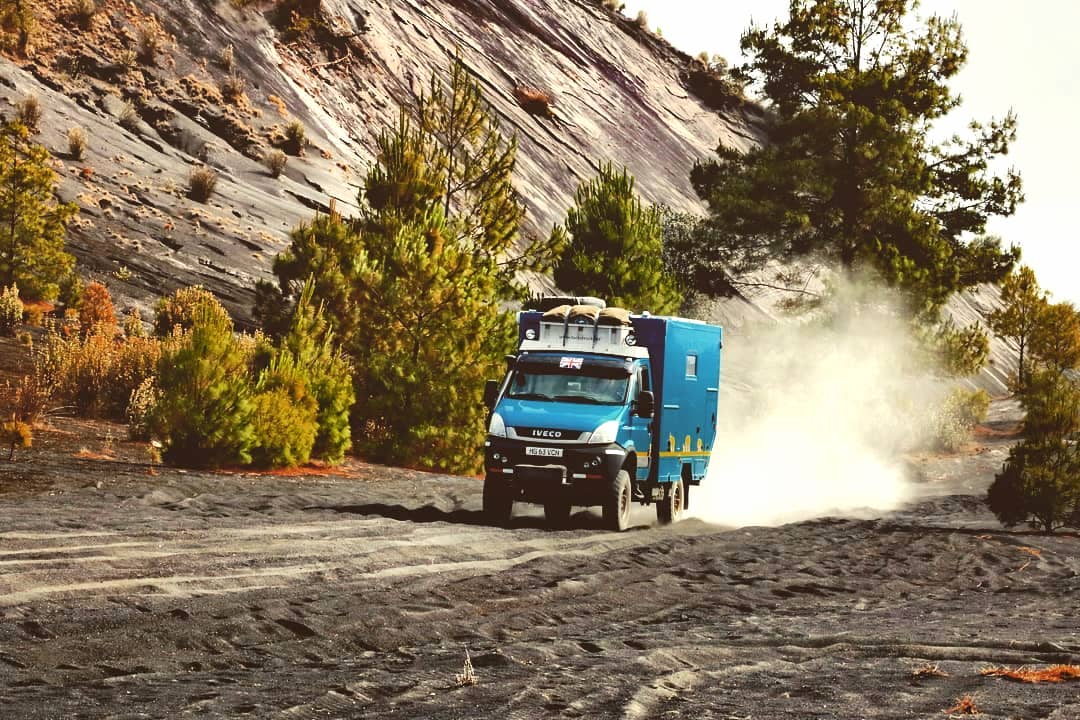
We spent a couple great days with Julie and Marcus. The conversations flew for hours over breakfast, lunch and dinner. It was so nice to discover how beautiful and complex they are. Besides talking about our road stories and the impressions on our sweet Ivecos, the coincidence was that we all worked in the Middle East region before departing on the overlanding adventure, thus there were more things to share. One day after breakfast we departed together to introduce Cuthbert to Brutus in what was a great encounter of these two distant cousins. Marcus quickly slid under Brutus to check the differences and similarities between the two trucks, and JP was amazed with Marcus gadgets and upgrades installed by Marcus himself on Cuthbert. This kind of encounters are priceless. Two strangers who suddenly become your friends, and with whom you realize you have so much in common.

After few days refreshing in Boquete we said goodbye to the Tucks and headed towards Panama City. We were so excited to finally visit the place famed by its strategic Panama Canal and its central role in the world’s maritime, trading and defense sectors. What would we find there? How would Panama City be like? these were the questions we were so curious to find out answers about. Somehow the expectations were high for that first-time encounter with the tax heaven of Central America. But not everything would be tourism for us. I had to get my prenatal done, JP needed a new passport and we had to organize ourselves with the paperwork and logistics to ship Brutus from Panama to Colombia. Busy days ahead for sure.
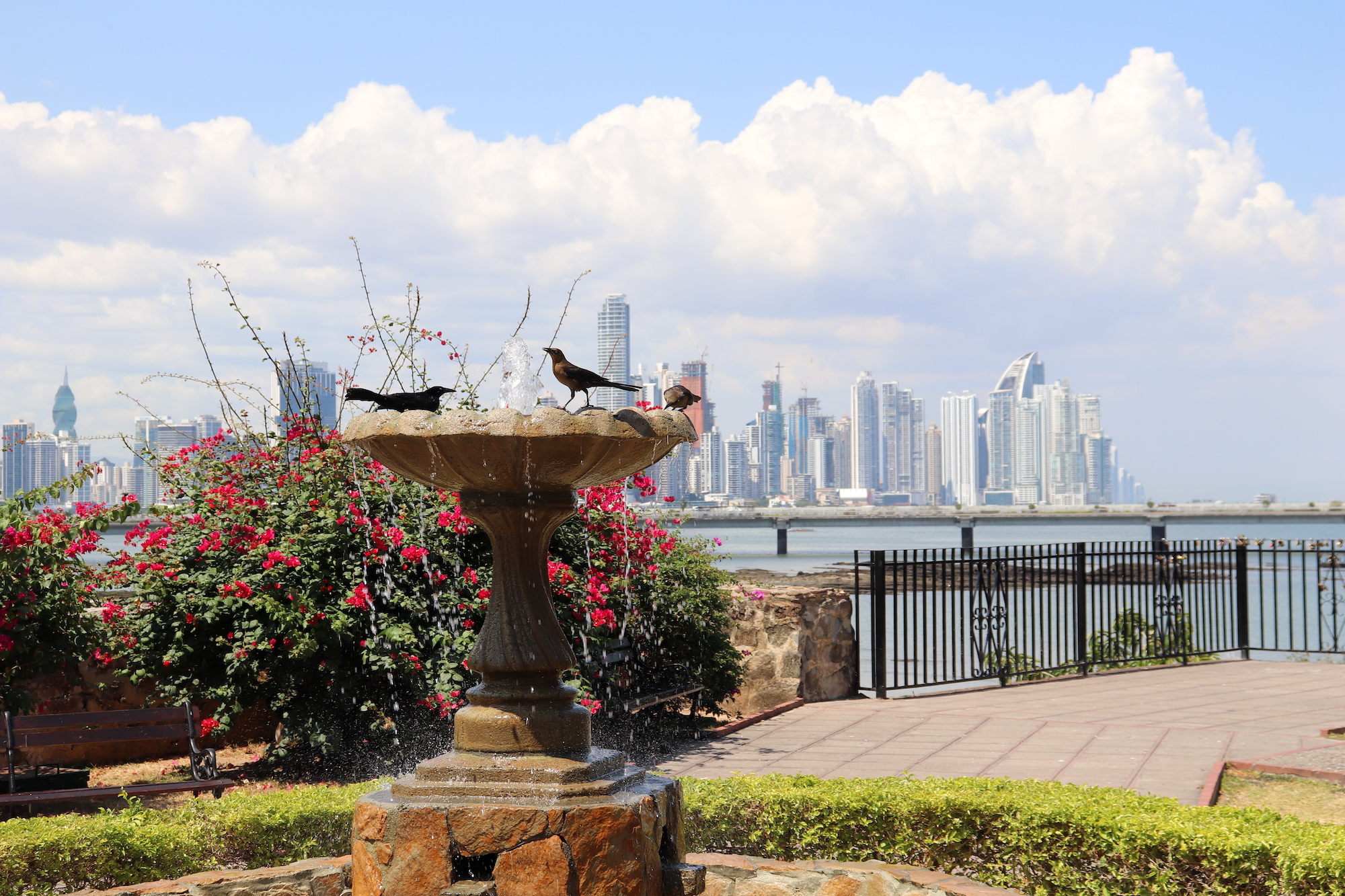
The road towards Panama City was nice and smooth. We advanced 400km in one single day without issues on a perfect highway. It felt great to ride on a proper freeway where traffic rules were respected. On the first night we decided to park overnight at a 5 star fuel station, if I can say that 🙂 Basically, it had all what we needed: clean bathrooms, showers, good internet, 24h service, great coffee, pastries and we didn’t have to pay camping fees! This was a true jackpot for overlanders passing by. Our first impression of Panama was of a clean country, with good infrastructure, and likely the most developed we had been to in Central America. On top of it, we could withdraw up to 500 U.S. dollars from ATMs. That was good news since we had to pay 1500 U.S dollars in cash for Brutus’ shipment.
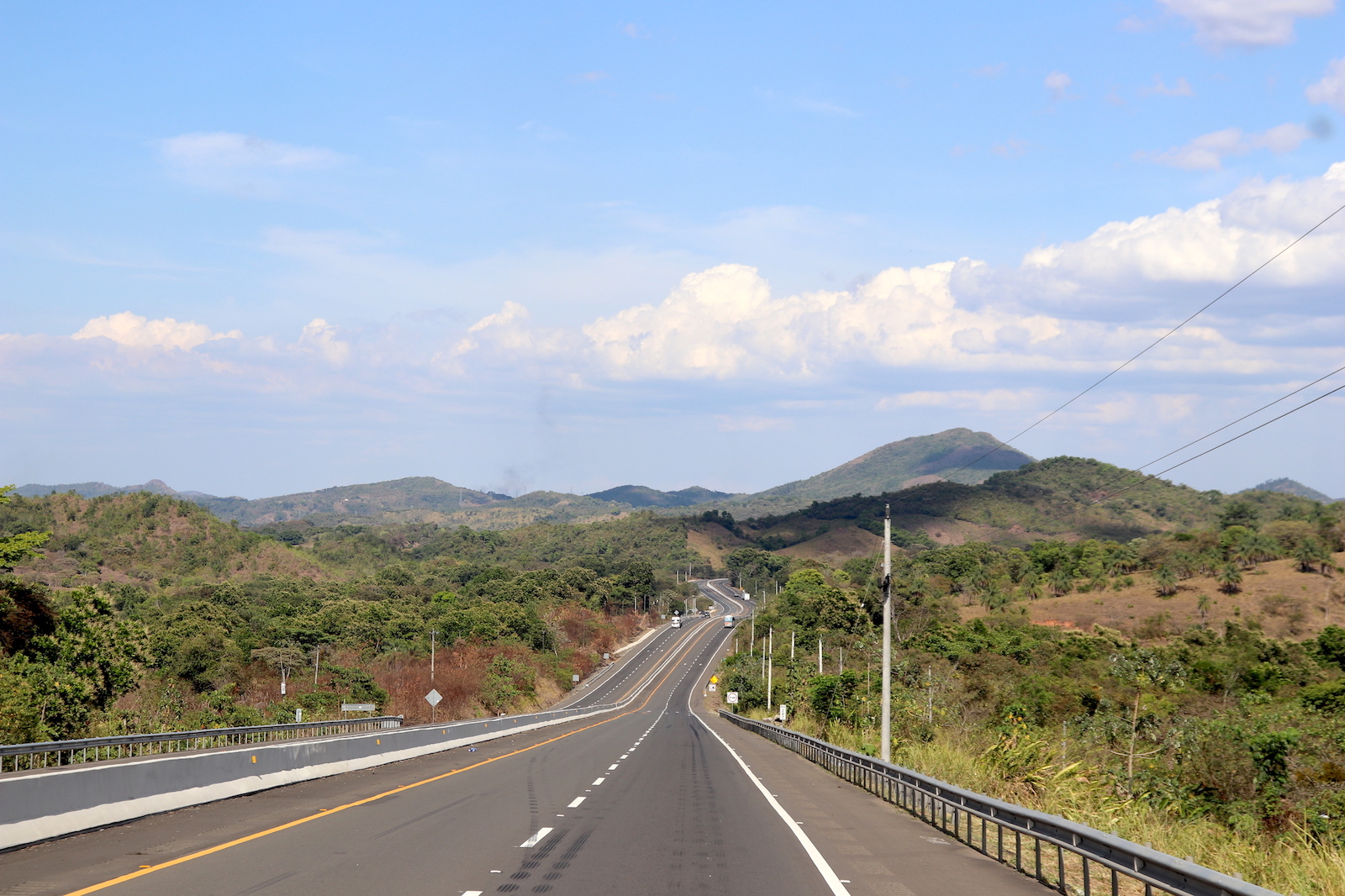
Panama City
When we got closer to Panama City the traffic started and it was inevitable. We entered the city via the very large Puente de Las Americas and that was jaw dropping! A vast bay was opening below us, the place where the Panama Canal meets the Pacific Ocean with the mammoth commercial vessels passing through. In the horizon the tall skyscrapers of the city center were making an impressive entrance view. Definitely a big change from what we had seen thus far in Central America. It felt like coming back to cosmopolitan times, and somehow, we liked that feeling.
Once we got into the city, we went straight to the fancy offices of Hoegh, one of the RoRo (roll in roll out) liners that owns the large car carriers which would carry Brutus from Panama to Colombia. It was a bureaucratic process and we wanted to get going with the paperwork as soon as possible.
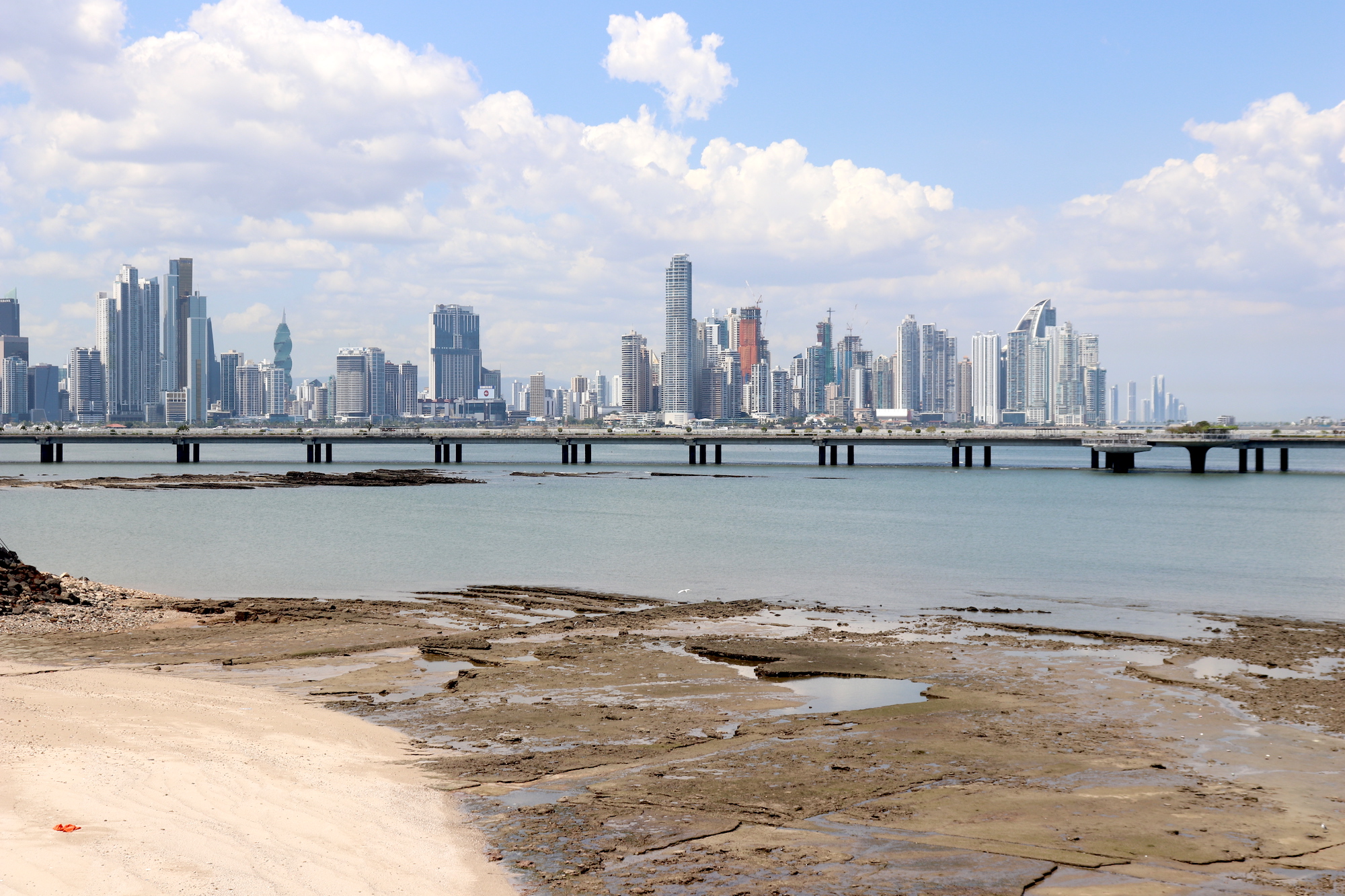
There was no way around it. A couple years ago it used to be a ferry traveling this route but unfortunately it is no longer operating, so the shipment of Brutus on a RoRo vessel was a must do since he is too large for a container. It would be the same process we went through when we shipped Brutus from Belgium to Canada, when we had no issues with the shipment. That means delivering Brutus at the terminal, close the living cell on the back, and hand over the keys of the driving cabin to the terminal crew. The terminal crew would drive in (roll in) Brutus over a ramp to a designated spot inside Hoegh’s RoRo vessel. Once the RoRo vessel would arrive in Colombia, the local terminal crew in Colombia would drive out (roll out) Brutus down a ramp to a designated spot at the terminal, where it would wait for us to be picked up.
For those hoping that the Panamerican Highway would continue without interruptions all the way over 30,000km from Prudhoe Bay to Ushuaia, I am sorry to spoil your hopes as there are no roads between Panama and Colombia. On the Panamanian side, the road ends at the town of Yaviza. From there is about 100 km of deep jungle, swamps and forest. This area is called the Darien Gap. Due to its size, difficult access, no infrastructure or presence of public services, the Darien has been lawless, and the home of criminals, smugglers, drug cartels and paramilitary groups. No, thank you. We passed that one.
It is not that nobody ever considered building the road between the two countries. Efforts were made by different players in 70’s and 90’s; however, the financial and environmental costs of building a road over deep forests and wetlands were just too high for anyone to bear. The political tensions between Colombia and Panama did not help either, adding to the lack of interest. Therefore, despite the existence of a 225km long overland border, transporting anything between Panama to Colombia is very expensive because it must be shipped. And unfortunately, the same applies to our dear truck Brutus.
There are two RoRo shipping line options for trucks the size of Brutus from Panama to Colombia. Both are circular line services serving also a few countries in the Caribbean; however, one route takes 4 days and the other just about 20 days. Besides the transport time, there are 3 other differences between these 2 routes: firstly, the long route circles the Caribbean on a clockwise direction passing by many Caribbean countries before reaching Colombia, whilst the other route runs on an anti-clockwise direction: straight from Panama to Colombia. The second is the way the truck is loaded inside the ship: on the long route it is RoRo, with the terminal staff driving your truck inside the ship, whilst on the short route your truck goes on top of a flat rack container. The third and last difference is the price: with the long route RoRo costing half of the $3500 asked for the flat-rack container on the short route. We decided for the long route at about $1500, yes because it was cheaper, but also because we could use some time off Brutus at a comfortable hotel in and around Cartagena.
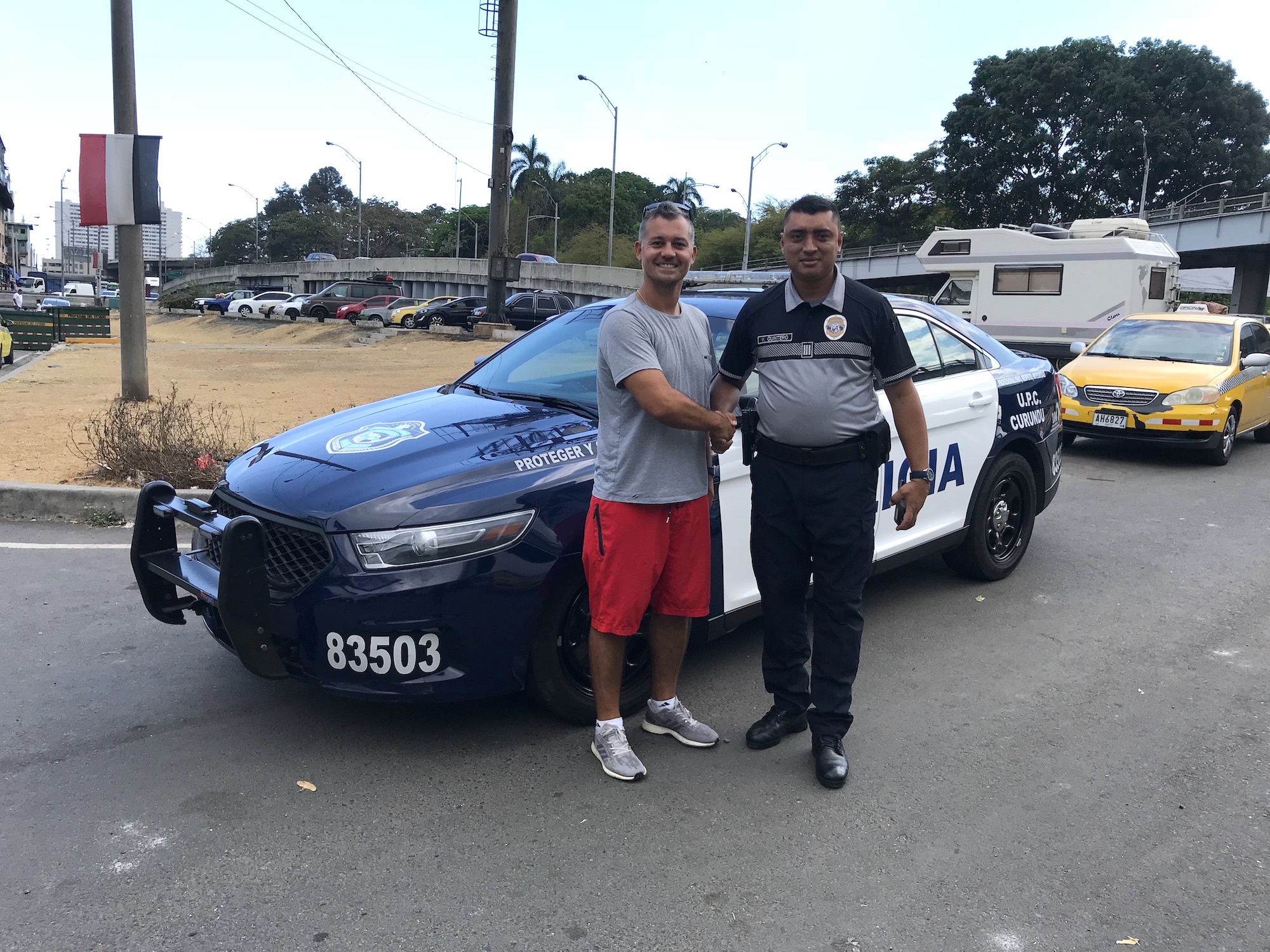
But hold on, if you think the shipment procedure is just like in EU which is all about driving to the terminal, paying the shipment and getting at the other side you could not be more mistaken. There is one shipment a month, you have to book it with at least 15 days in advance, you must pay in cash and get the shipping documents to be able to proceed with the export inspection for of the vehicle at the DIJ ( National Directorate of Judicial Investigation). The inspection is to ensure your vehicle or its engine wasn’t robbed elsewhere before being shipped to Colombia. It is a prerequisite to ship. To make things complicated, the chassis and engine inspection are done at a quite unsafe area, and because only 25 vehicles are inspected a day you must be there very early. We arrived at 06:00 and were the number 15! While we were waiting the police came by to warn nicely about being vigilant and to take care whilst waiting as pickpocketing and theft were frequent in that neighborhood. Well, not ideal yet we were lucky to meet other overlanders there and we stayed in a group of people chatting and laughing over our traveling stories as the time passed by. Interestingly, being at that poor neighborhood gave us the opportunity to see the Panama City from other perspective: following its most imposing and richest side when we arrived, we were now seeing its decaying and poor neighborhoods on the outskirts. It was shocking to see the huge gap of social classes.
Conversations flew while we met Julia and Tim, a German young couple that were overlanding the Americas in an Iveco Daily 4x4 similar to Brutus. They were so friendly and sweet. There was Peter as well, a German traveling alone in his modern VW Combi along with his great sense of humor. Peter was telling us about his experience in Costa Rica, when he was robbed at gunpoint while camping on the beach. We were shocked! The thieves knocked his camper door in the middle of the night and pointed the gun towards him and his girlfriend. They wanted money and valuables which Peter managed to negotiate nicely. It was sad and awkward to hear about this happening in Costa Rica since most travelers expect Costa Rica to be safe. When crossing Central America people tend to relax when they reach Costa Rica and Panama. Most think these two countries are more developed and popular as touristic destinations, thus safer. But obviously it was not the case. The danger was there at any corner and we had to be careful especially in Panama at the end of our Central American adventure. Peter got away that time without a scratch, but for sure he will never forget the trauma of being threatened at gunpoint. He was still on the road, excited for his adventure, so I guess he overcame it fast 🙂
For all these reasons we chose not to wild camp on the streets of Panama City even if there were some good recommendations to stop at the Balboa Marina. We decided for a well-located hostel in a very green neighborhood of old colonial houses. At the hostel we would have two options: to sleep in the truck inside the parking lot paying a small parking fee or to get accommodation inside the hostel if we would be needing some AC time.
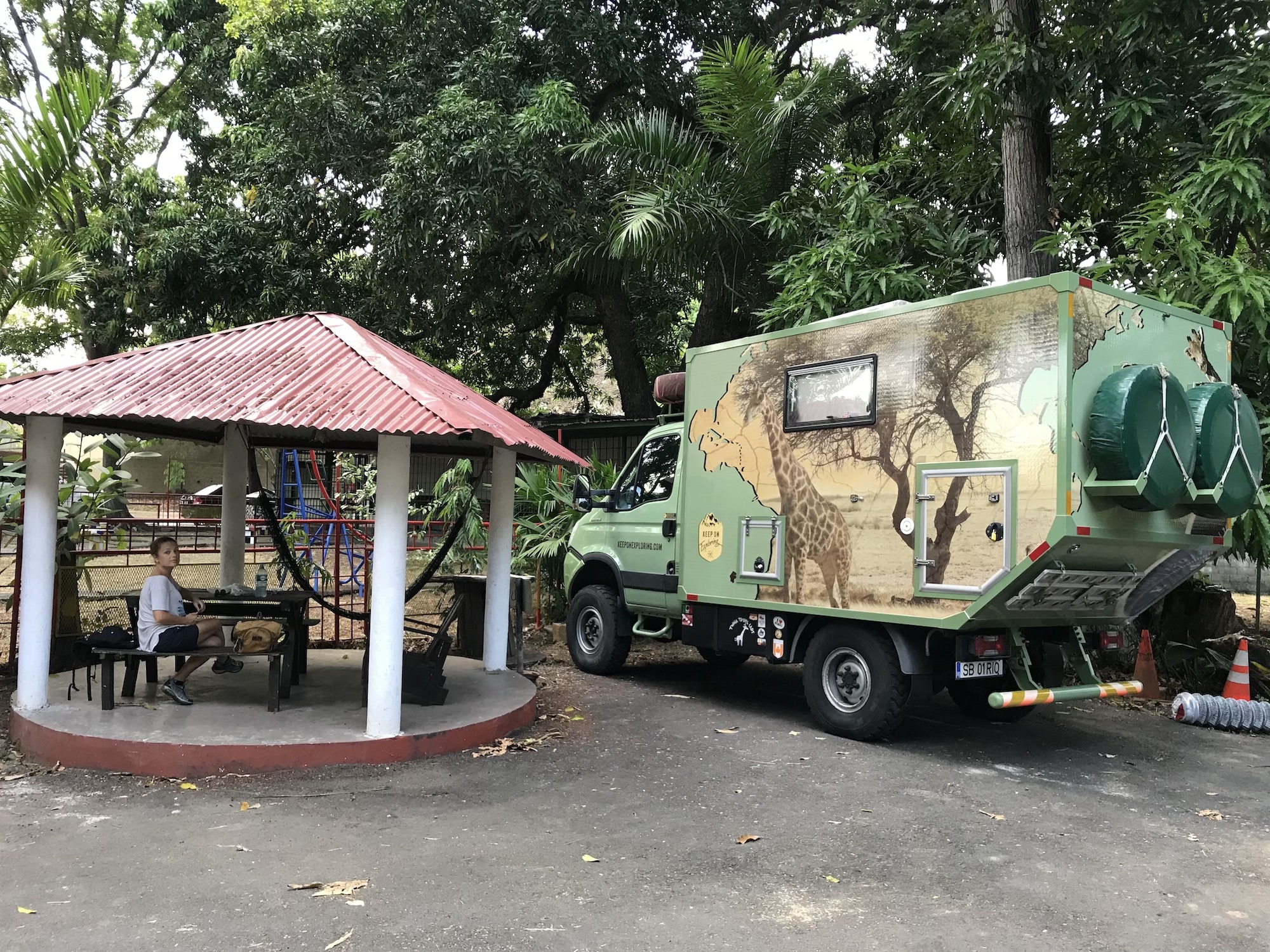
It turned out to be exactly what we did: we had two nights in the truck and soon we realized we needed some AC time. The heat and humidity were chasing us in there too. We got accommodated inside the hostel for the rest of the days left in the country as we were waiting for Brutus to be shipped over the Caribbean. We took advantage of that time to work on the truck maintenance, to visit the touristic parts of the city, to renew JP’s passport and although it was a little bit early in the timeline I had my first pregnancy scan and blood tests.
Casco Viejo
This is one of the most beautiful and historical parts of Panama City. We took our bicycles from Brutus and strolled down by the Cinta Costera, which has a designated biking lane that goes all the way straight to the Casco Viejo. We were welcomed by a gorgeous view to the bay, in front of us we saw the imposing tall buildings of the city center while on our left side we had Casco Viejo with its Spanish colonial architecture.
Panama City was first founded in 1519 and did not last longer than 150 years until the city was set on fire on the attack of a renown pirate named Henry Morgen. After one year the city was reconstructed from scratch and built on a peninsula isolated from the sea, which would act as a defense system from future attacks. Today one can find the old Panama City in Casco Viejo, or San Felipe how it is also called.
We were really impressed by the architecture style of San Felipe. Something we didn’t see before in Mexico and Guatemala. It had higher buildings with an aristocratic style, plenty of well-maintained governmental buildings, churches, palaces and pleasant squares. The restaurants available did not disappoint either. We had the best pizza in a long time.
The Causeway
The following day we went out on another biking adventure on the Causeway. This is a four-lane road with a perfect infrastructure for biking and jogging that connects the mainland with four little islands called The Causeway Islands. This part of town is considerably developed having world class port facilities, marinas, restaurants and shopping areas. It was very pleasant to ride along the Causeway as we could admire the bay on our right and left side and the lofty view of the city in the distance. We ended our tour with a satisfying lunch and a short visit to the Biomuseum which is focused on the natural history of Panama.
Overlanders meeting point - Amador Familiar Hostel, Panama City
Back to Amador Familiar Hostel a spontaneous social scene emerged. It seemed to be a meeting point for overlanders across the Americas. Throughout the days we stayed there we met very interesting and inspiring travelers.
Natalie is a French woman who was cycling the Americas. We learnt from her how she is managing biking on her own and how different it is when compared with our experience driving. She explained with an optimist and full of life tone that what she is doing is very easy :))) I bet! She said one needs two weeks only to adjust to the road, then everything is normal. She doesn’t find it dangerous, on the contrary she finds it safe. Natalie was saying that she can sleep everywhere: in people’s houses, courtyards, police stations, fire stations, everywhere she finds shelter. She uses an application as well for cyclists called “warm shower” and “coach surfing”.
Natalie confessed that she has more contact with the land, the nature and with the people than us, the ones traveling in vehicles. She looked well-seasoned for any type of environment, people or situations. She cycles every single day from 6:30am until 1-2pm, about 90 -120km/day. After 2pm she looks for a place to sleep and rest. She eats about 3500 calories per day, almost as two people.
She spoke in such an easy, natural and confident way that she made us believe it’s something we could do right away without any training. We were blown away by her experience cycling around the world and mostly by her determination and courage. I could never image doing something like that on my own. I was thinking at all those bad roads full of trucks that cross with high speed and at all those bad drivers that don’t respect the rules in traffic. On top of this the dust, the rain, the possible attacks are considerable risks when cycling the Pan American highway. Not for me, thus even more credit to Natalie’s courage.
That evening while we were having our dinner in the common kitchen area we met other travelers: a young Dutch couple that we had met before on the North Rim of the Grand Canyon. What an amazing coincidence. Who would have thought we would meet them again in Panama City? Meeting people we’ve seen before gave us some sort of confidence that we are on the right track, in the right spot and time.
There was a Japanese as well who spoke fluent Spanish and Portuguese. I found him an exotic character: the first Japanese we met on the Pan-American highway. Other three bikers which were riding from California brought a funny atmosphere into the set. Out of the blue we were all in a social environment, talking to each other, talking over each other and laughing.

My first “Hello” to Luca
The much-awaited moment of my first pregnancy scan finally arrived. In the morning we left early to a very good local hospital to perform the prenatal checkup. I was only 9 weeks by that time, a bit early in the process, but we had a window of opportunity in Panama City while waiting for the truck shipment. We knew they had a good health care system there and after that our best chance would be in Medellin, Colombia. We could not wait for that long. We wanted to be sure all was going well with the baby. I remember I was so anxious and excited at the same time. I feared bad news and I wished so much that everything was well. My anxiety went away when I saw the first scan... It was so emotional and unique. I couldn’t really believe that there was a human being developing inside my body. I saw it moving its hands and head. It was incredible! The doctor was surprised to see it too. He said it was big for his age :))) I thought it had maximum 9 weeks by that time, but the echograph was showing that he had 10 weeks and 6 days and a bit over 4cm. This gave me a sense of confidence that everything was alright. I really hoped all would be well all the way until the delivery. It was some sort of fear mixed with excitement and hope, something I would carry with me all the way whilst I was pregnant. My fears were no longer the dangers of the road, but of anything that could somehow harm my baby. I was so relived and content that day when the doctor’s confirmed that we were both doing well.
I have chosen a nearby restaurant to go and celebrate the great news. By accident I ended up in the middle of a vibrant Jewish social scene enjoying a kosher breakfast: omelette, hummus and tsatski. I ordered as for three people, but who cared? I was so hungry and so happy. It was time for a well-deserved feast!
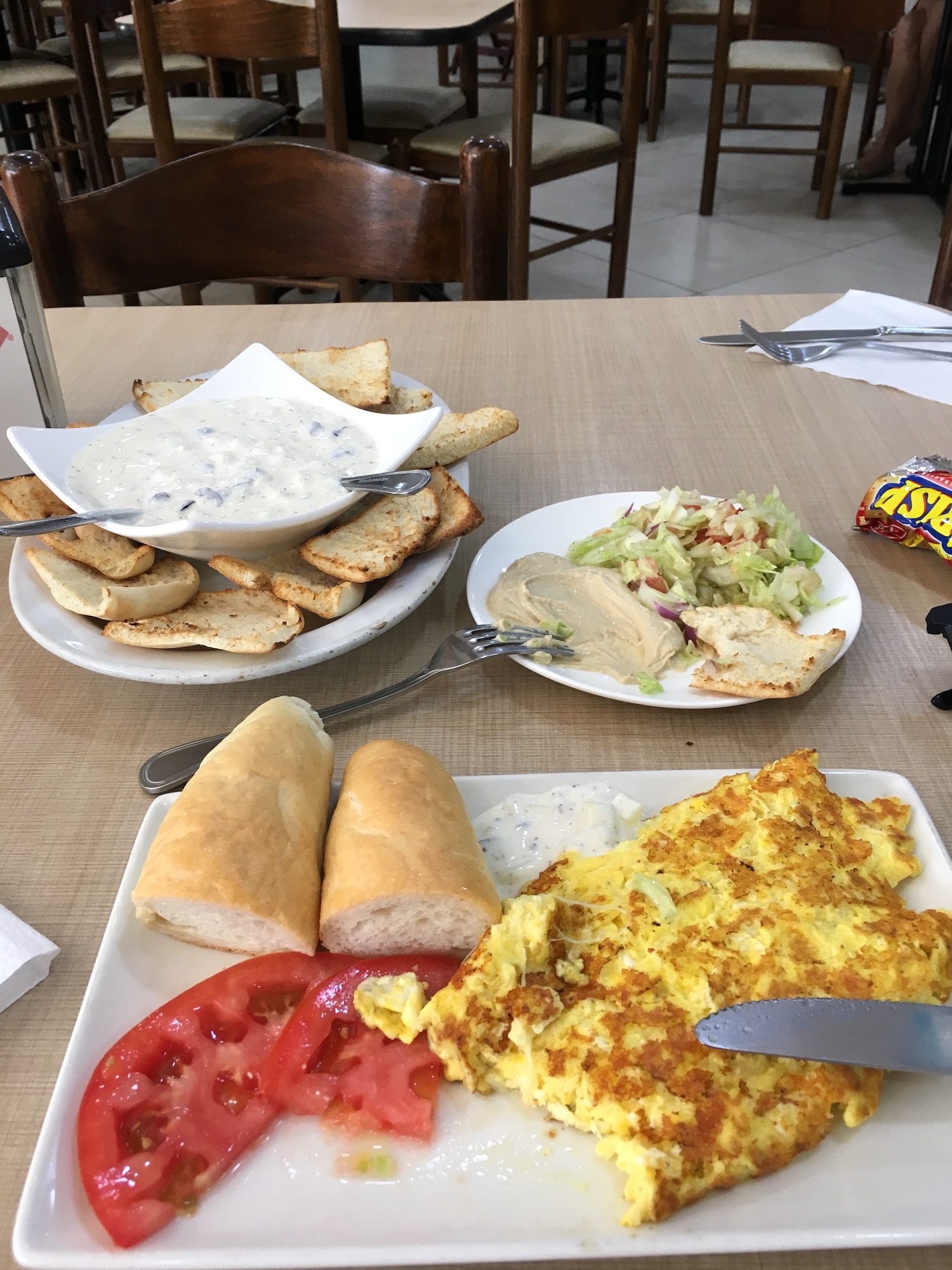
In the meantime JP was servicing the truck at an IVECO dealer, doing the regular check-up and rotating the tires. It was a pity that he missed this first miracle, but I was sure he would not miss the next one when we would probably be able to identify the gender of our little ‘bean’ as we would kindly call him at this early stage of development.
When we met back to the hostel I shared the great news with JP who was still processing everything that was going on :))
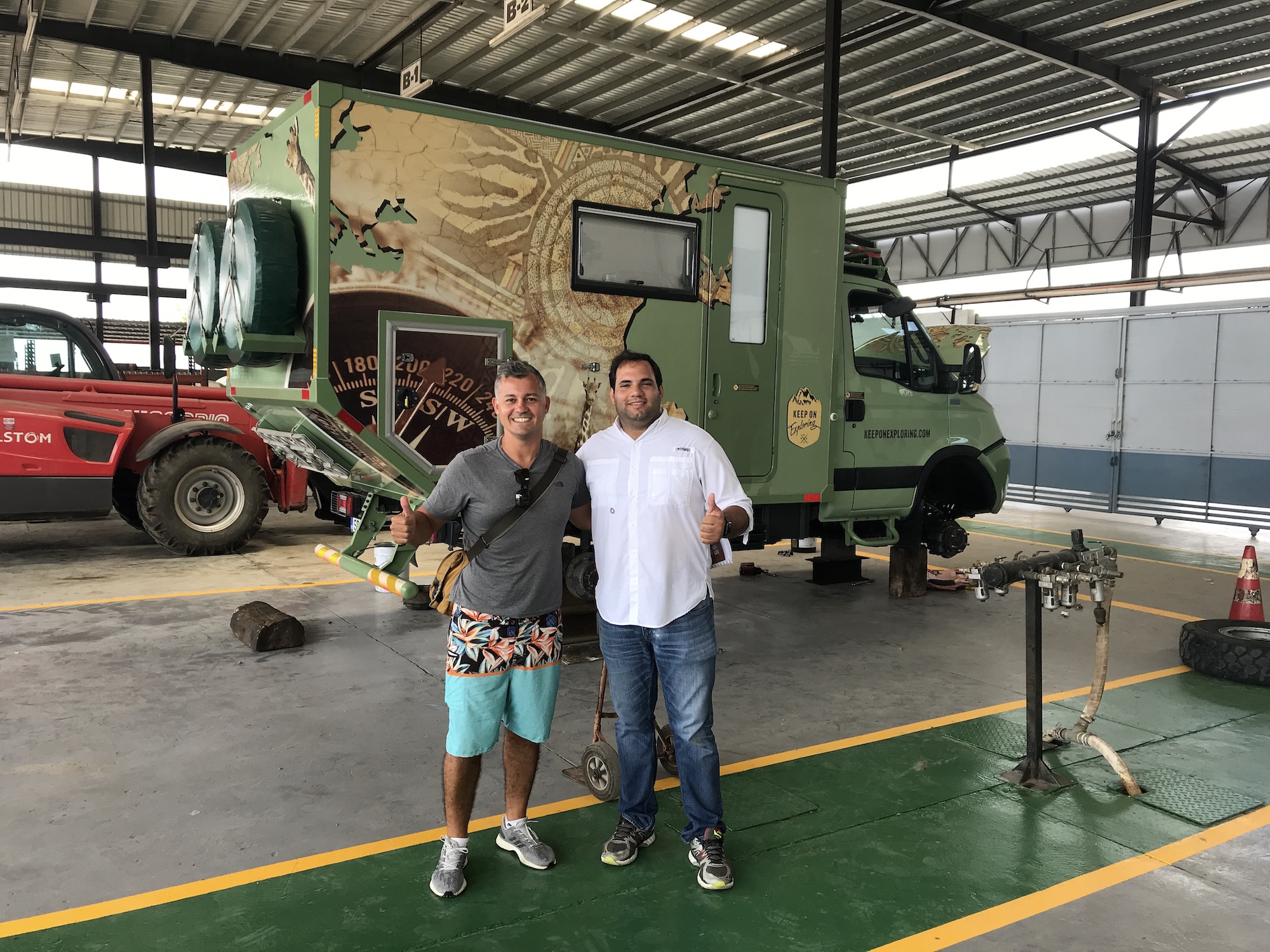
Panama Canal
The time came to prepare the truck for a three weeks shipment over the Caribbean Sea. We had to clean it, to deplete the food storage, the fridge, to empty the toilet box, select the clothing, documents, toiletries and electronics that would stay in the truck and the ones we would take. We managed to get all these done by 1pm when we departed towards Colon. But before reaching the port we stopped on our way to Miraflores locks, the Panama Canal visitor center.
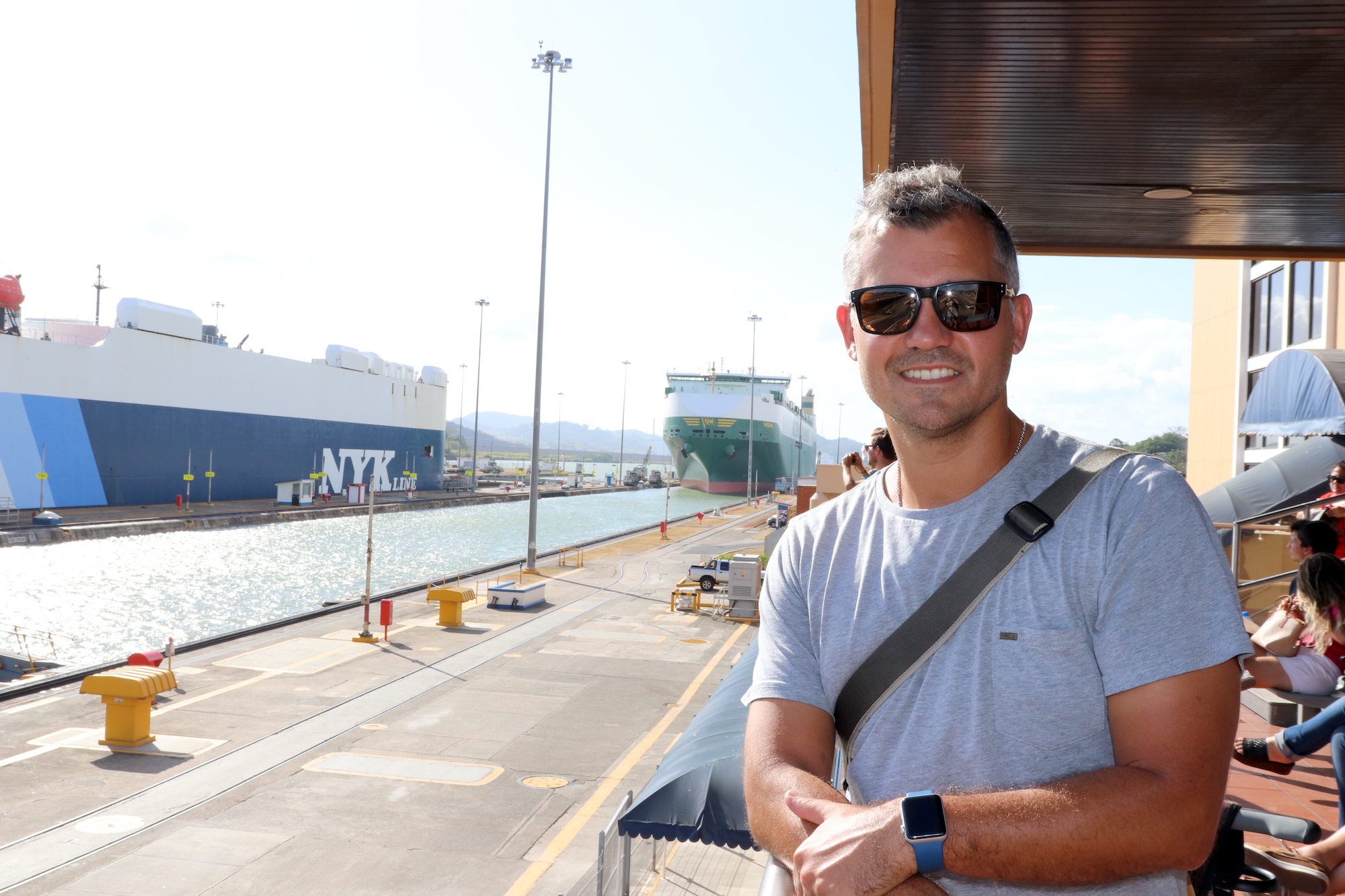
As we were entering the visitor center we met a French family traveling by bicycles with their three children. They were the very same family we came across in Palenque, Mexico a couple months earlier. We were shocked to meet them again at the Miraflores Locks. That meant they reached Panama City biking with their three kids at the same time we reached it with our truck, all the way from Mexico! We are talking here about unbearable heat and tough road conditions even by a motor vehicle. It was mind blowing, and doing it with three small children? That encounter really made me more ambitious and determined to stop complaining for any nonsense when things would get challenging on the road. After we exchanged contacts we departed excited towards the canal to catch the huge carrier that was about to cross the Miraflores Locks. Wow!
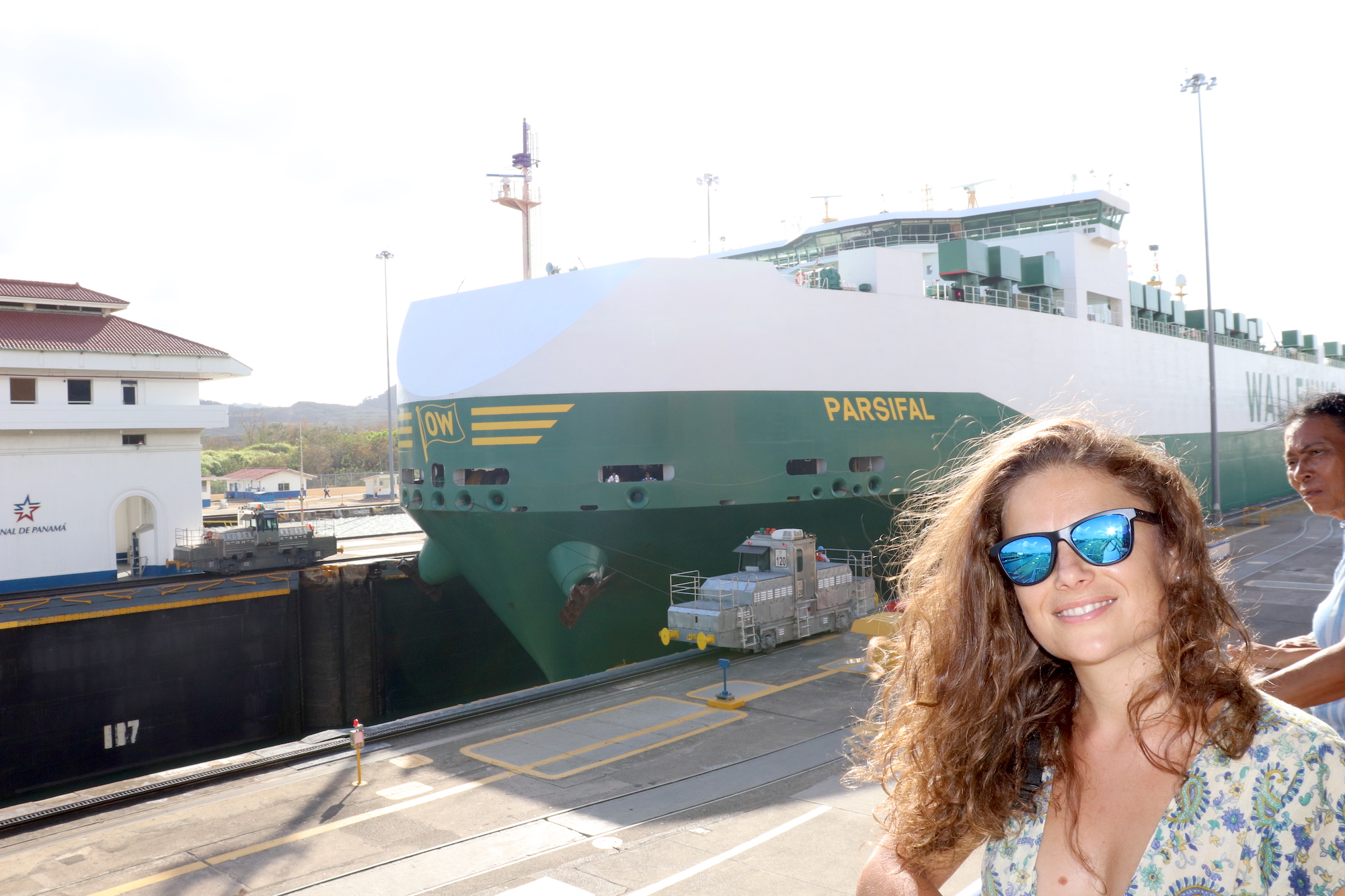
For the ones who do not know, the Panama Canal is an extremely strategic man-made channel. It plays an essential role in the global trading as it cuts through the center of the Americas, connecting the Atlantic and Pacific oceans. The canal has a length of 80km, and a vessel takes from 8 to 10 hours to cross it. It can cost from 5000$ for a small boat up to 1,000,000$ for the largest carriers to fit transiting the canal. It is also strategic from the defense perspective, allowing battle ship to transit quickly between the Atlantic and the Pacific. Not surprisingly the Americans were behind the conclusion of the canal and not until recently held their operation.
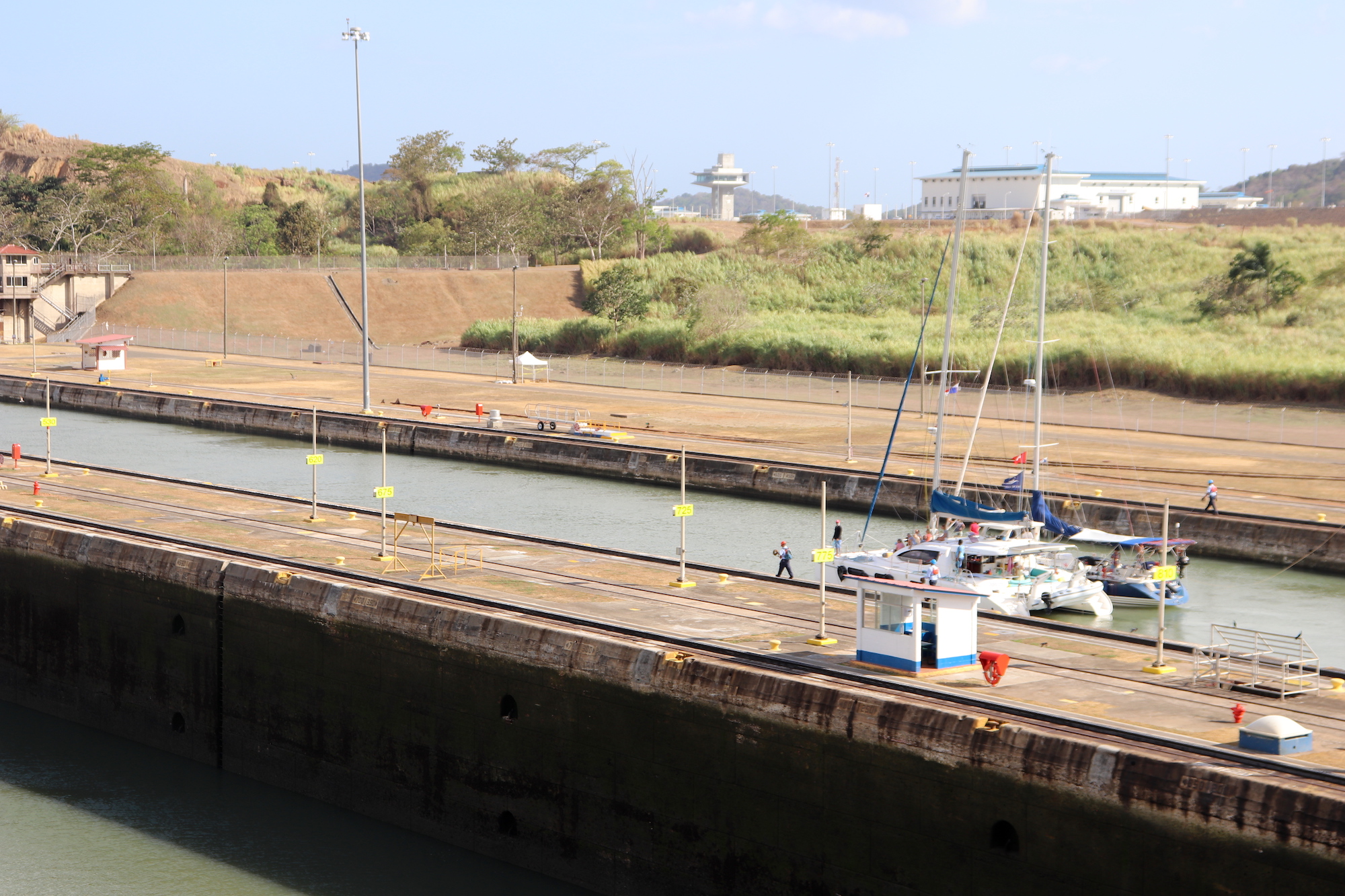
The waterway uses a system of three locks complexes, each one with two lanes that operate as water elevators that raise ships from the Atlantic Ocean level to the one of the Pacific Ocean. When the ships get to Miraflores Locks they are lifted about 16m to level them up for the Pacific Ocean. Fascinating!
The canal started to be built by the French, which later on abandoned the project when the people working for the canal were highly infected and died of yellow fever, malaria and other tropical diseases. In the beginning of the 1900s the Americans took over and were determined to finish this masterplan. There were people working from all over the world over a period of 10 years. Migrants came from Bahamas, Jamaica, Trinidad, Colombia, Panama and Europe.
It was extremely interesting to understand that ships were built worldwide to meet the dimensions of the canal. If they wanted to eventually cross it, they could not exceed the width and capacity of Panama Canal. The maximum dimensions for vessels wishing to transit the canal back then were 32.3 meters wide, 294.1 meters long, and 12 meters of depth. It remained under US control for years, but in 1977 the US President James Carter and the Panamanian General Omar Torrijos have set to complete the transfer of the waterway to Panama and end the US military presence in the country. So after a period of joint American–Panamanian control, in 1999, the canal was taken over by the Panamanian government. In 2006 Panama decided to expand the waterway and after another 10 years, the expansion was inaugurated with the canal third set of locks in 2016. The expansion allows the passage of larger vessels of 49 meters wide, 366 meters long, and 15 meters depth, carrying greater cargo volumes, ultimately impacting the world’s economy and thus consolidating Panama strategic position.
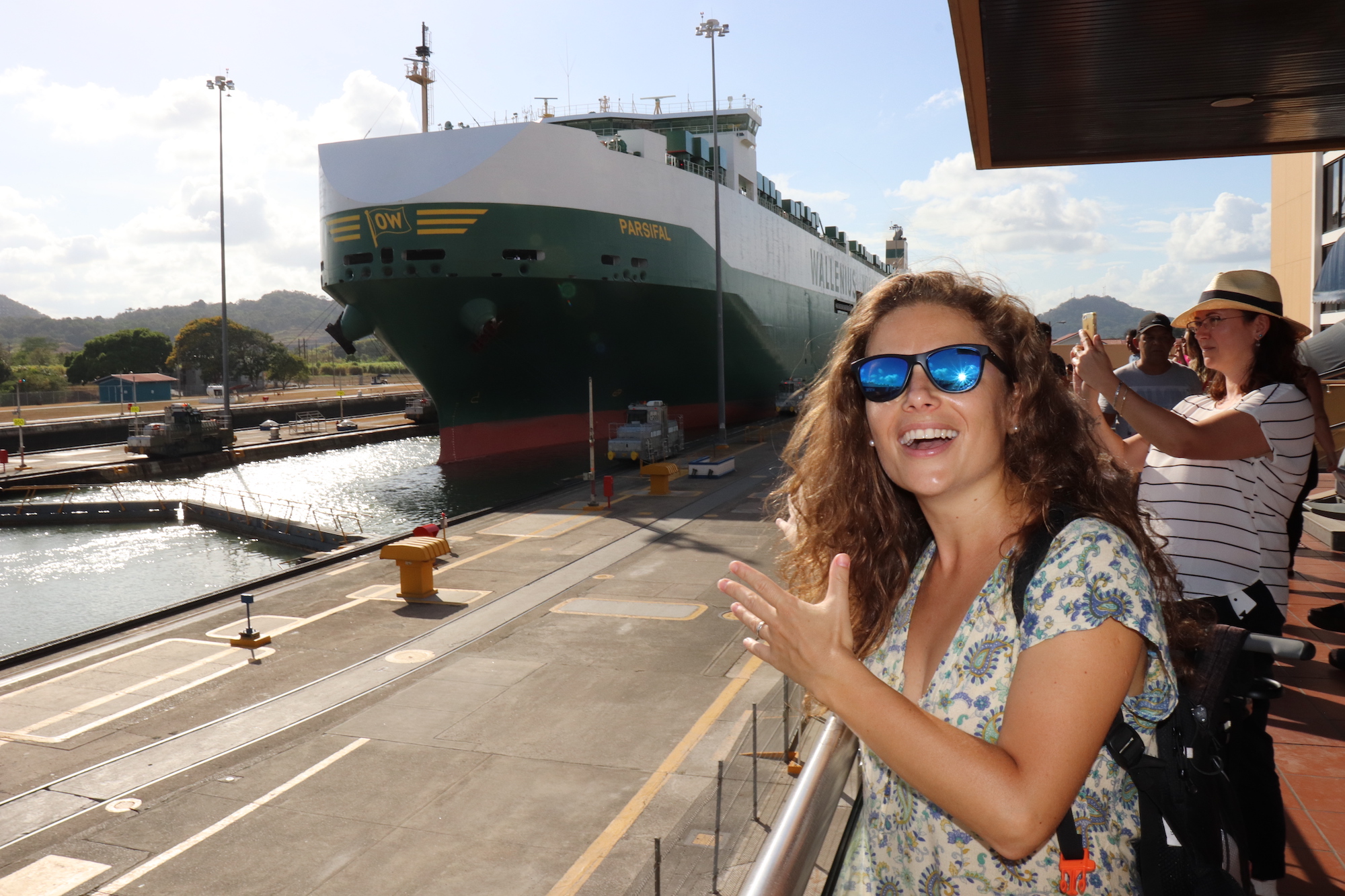
What a refreshing, exciting and fun visit! Finally, we came upon something different, something new, something mind-blowing. After this visit we continued on the other side of Panama towards Colon and Manzanillo port where Brutus would be shipped to Santa Marta, Colombia. The large RoRo liner vessel would take Brutus on a trip up to Miami before getting back to Santa Marta, Colombia. This could take up to three weeks. We heart so many beautiful things about Cartagena and the Tayrona National Park near Santa Marta that we did not mind waiting Brutus there for three weeks. Bad decision! You will find out later on our next posts why.
Bye bye Brutus - See you in Colombia!
When we arrived at Manzanillo it was a bit of a walking and knocking at all sorts of doors for papers and stamps. The process was not very well signaled, it was a bit of a mess. We had a small adventure finding the right offices and parking places, but nothing major or nothing that we couldn’t sort out. After getting the stamps and all the paperwork our truck was inspected by the customs authorities and the police. For the first time we had a dog sniffing inside our motorhome for drugs. It was funny as JP was super nervous with the dog entering the truck with dirty paws since it had rained, and the dog was leaving all sort of dirt footprints. After all we just finished to clean the truck and prepared it for the journey. Luckily the dog didn’t spend too much time inside, it went around the cabin, but he didn’t seem impressed 🙂 He acted confident, comfortable and appeared to know very well its routine. It was cool to watch it in the end.
After this process we waited for the last documents to be released. Everything came on time and soon we departed with our backpacks to find a taxi that would take us to the bus terminal and back to Panama City. By evening we were back to Amador Familiar Hostel for couple of more days before flying to Cartagena, Colombia where we would wait for Brutus.
When we took that flight to Colombia we felt somehow relieved that we closed the Central America chapter and were departing towards the third and last part of our journey, South America. I must confess that crossing so many borders in Central America often on high heat was not the most pleasant exercise of our journey. But we did take away the wonderful diving experience in the Belize Barrier Reef, the iconic Maya ruins of Tikal, the fun we had in Antigua, Guatemala with our dear overloading friends, the friendships we built in Costa Rica, and the impressive Panama Canal. Above all, something very important changed: we had a third member joining our family and expedition crew throughout the Americas. Luca Nicolás, welcome on board! Colombia, here we come!

